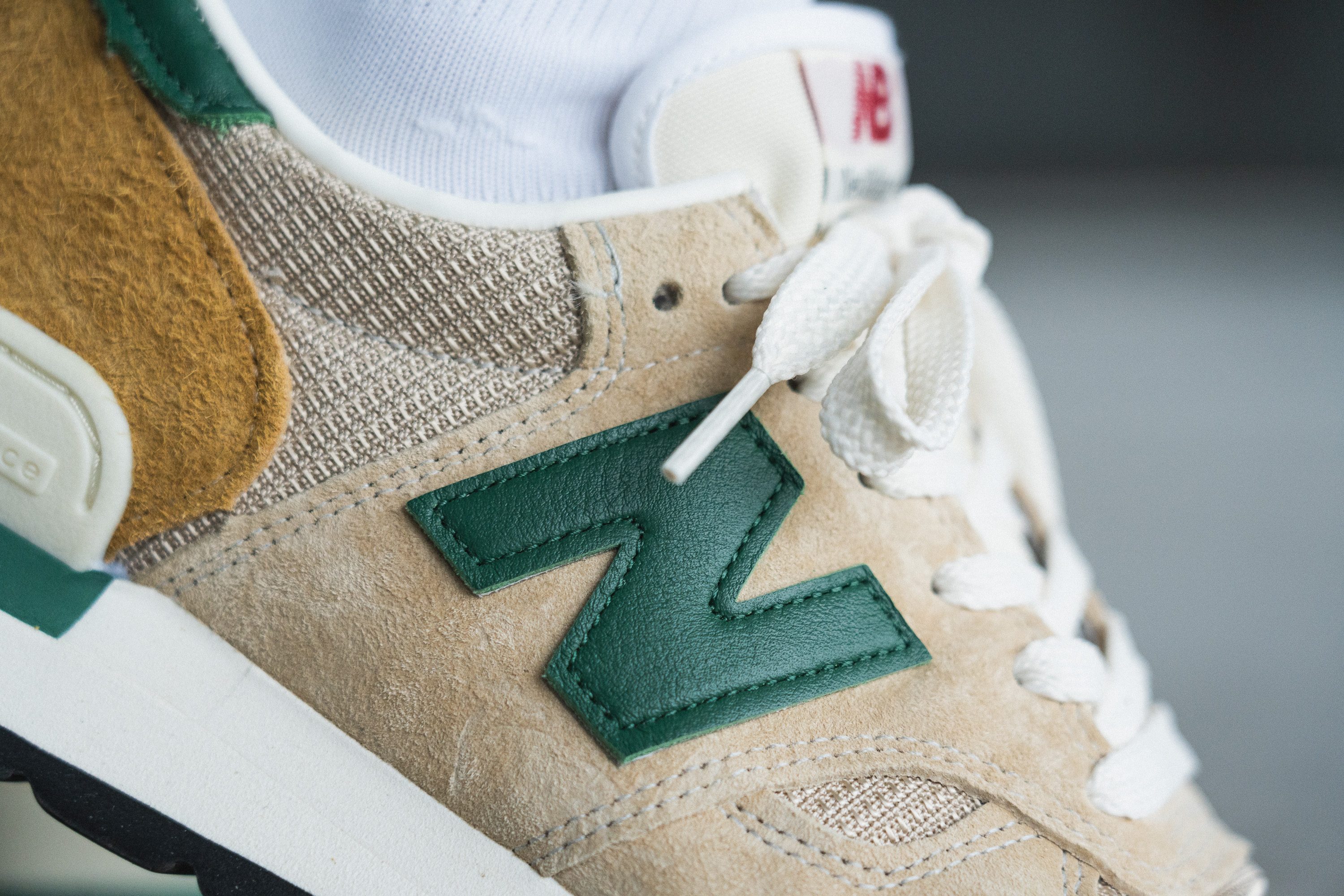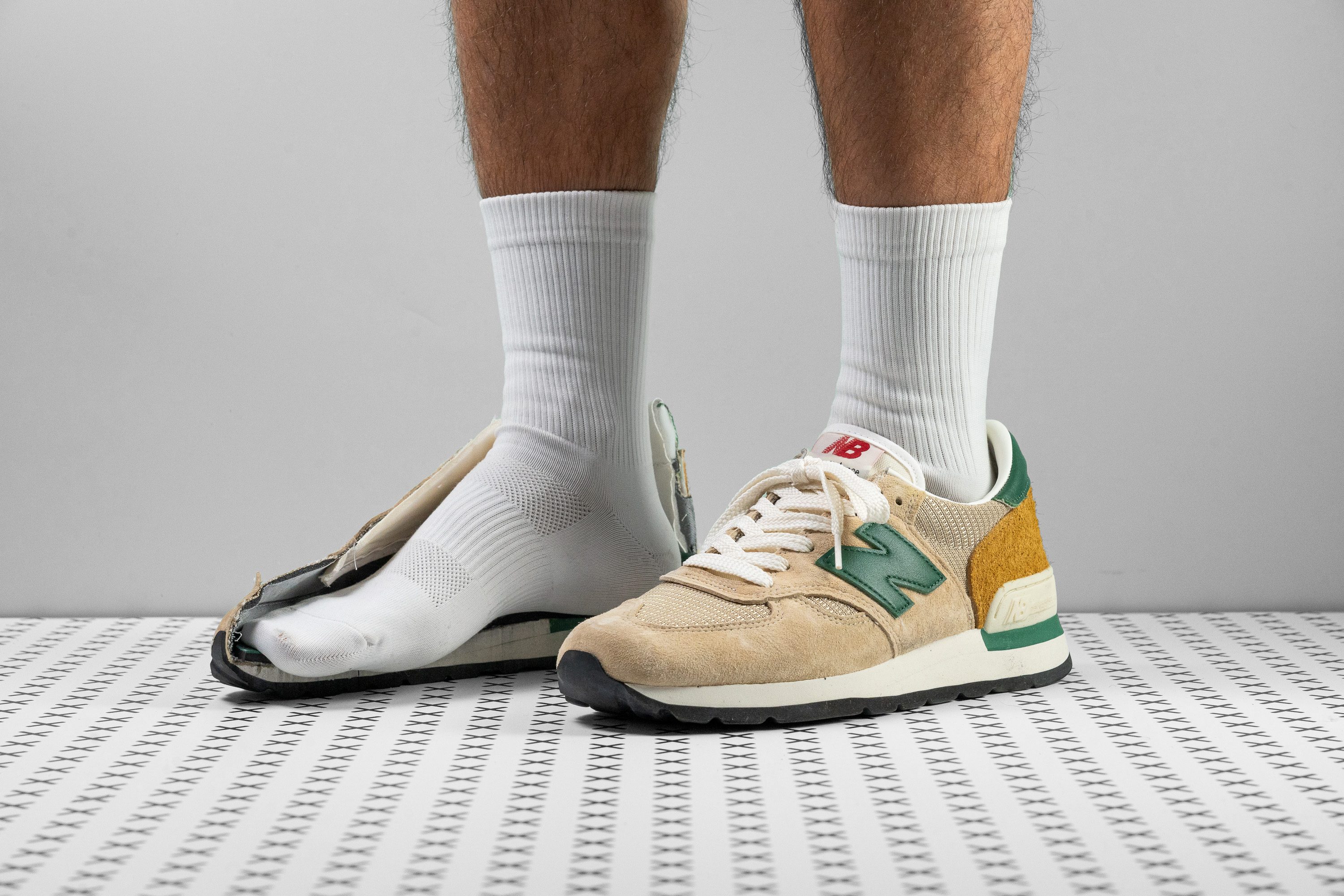Our verdict
Pros
- The most original 990
- Premium materials and craftsmanship
- Made in the USA
- Lighter than average
- Highly supportive
- Stable platform
- True to size and fit
Cons
- Pretty warm and lacks breathability
- Not very cushy or padded
Audience verdict
- Top 17% in sneakers
- Top 4% in New Balance sneakers
Comparison
The most similar sneakers compared
+ + Add a shoe | |||||
|---|---|---|---|---|---|
| Audience score | 94 Superb! | 86 Decent! | 92 Great! | 93 Great! | |
| Price | $165 | $200 | $200 | $150 | |
| Style | ClassicSporty | ClassicDadRetroSportyChunky | Retro | ClassicDadRetroSporty | |
| Shock absorption | - | Moderate | Low | High | |
| Energy return | - | Low | Moderate | Low | |
| Traction | - | Moderate | Moderate | High | |
| Breathability | Moderate | Breathable | Moderate | Breathable | |
| Weight lab | 12.9 oz / 366g | 12.9 oz / 366g | 14.7 oz / 417g | 14.1 oz / 401g | |
| Size | True to size | True to size | True to size | True to size | |
| Midsole softness | Firm | Balanced | Firm | Firm | |
| Material | MeshSuede | MeshSuede | MeshSuede | Mesh | |
| Season | SpringFall | Summer | SpringFall | SpringFall | |
| Inspired from | Running | Running | Running | Running | |
| Width / fit | Medium | Medium | Medium | Medium | |
| Toebox width | Medium | Medium | Medium | Medium | |
| Leather/suede quality | Real suede | Real suede | Real leather | Real suede | |
| Toebox durability | Decent | Bad | Bad | Decent | |
| Heel padding durability | Good | Decent | Good | Bad | |
| Outsole durability | Bad | Good | Good | Good | |
| Heel stack lab | 34.4 mm | 39.1 mm | 33.2 mm | 37.1 mm | |
| Stiffness | Stiff | Moderate | Moderate | Moderate | |
| Tongue padding | Thin | Average | Average | Average | |
| Drop lab | 12.0 mm | 15.3 mm | 11.2 mm | 11.5 mm | |
| Forefoot | 22.4 mm | 23.8 mm | 22.0 mm | 25.6 mm | |
| Removable insole | ✓ | ✓ | ✓ | ✓ | |
| Heel tab | None | None | None | Extended heel collar | |
| Torsional rigidity | Moderate | Stiff | Moderate | Moderate | |
| Heel counter stiffness | Stiff | Stiff | Flexible | Flexible | |
| Reflective elements | ✓ | ✓ | ✓ | ✓ | |
| Closure | Laces | Laces | Laces | Laces | |
| Top | Low top | Low top | Low top | Low top | |
| Ranking | #21 Top 17% | #110 Bottom 9% | #48 Top 40% | #21 Top 18% | |
| Popularity | #113 Bottom 9% | #69 Bottom 42% | #40 Top 34% | #18 Top 15% |
Who should buy
First released in 1982, it doesn't get more original than the New Balance 990 v1. We believe that this great founder of the entire 990 series would appeal to the following folks:
- connoisseurs of the eternal classics
- seekers of premium quality in a shoe that's proudly crafted in the USA
- guys and gals who want a bit less athletic-looking sneaker from the 99X collection
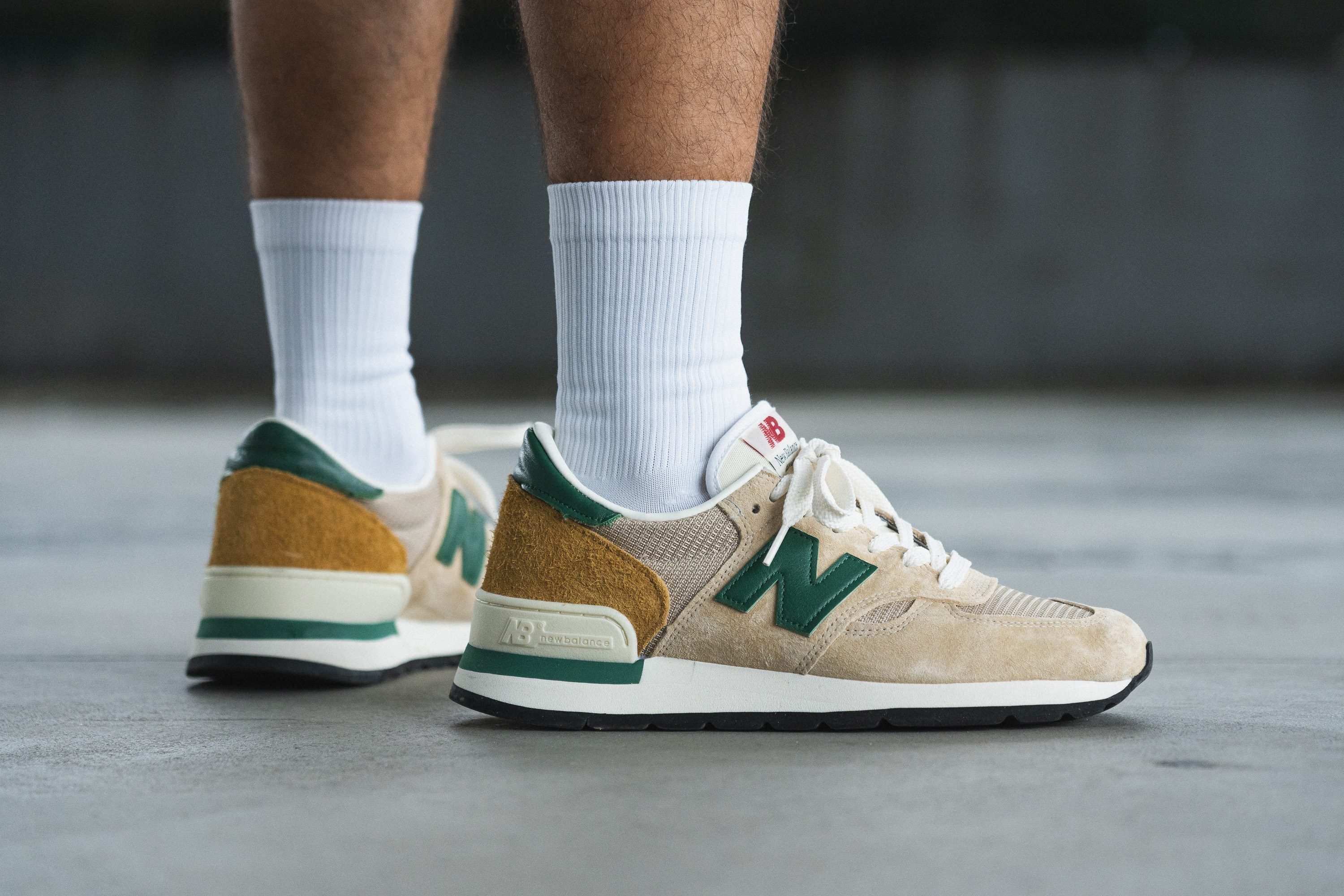
Who should NOT buy
If you are in love with the silhouette but are taken aback by the price, New Balance offers at least two budget-friendly alternatives that are easy to confuse with the 990 v1. The 997H and the 574 are both retailing for only $90.
You might as well lack cushioning in the v1, especially if your feet have been spoiled by the marshmallowy sneakers of today. In that case, you will enjoy the succeeding 990 models more (i.e. the 990 v6) as they come with ABZORB foam, have more tech, and feel bouncier as a result.
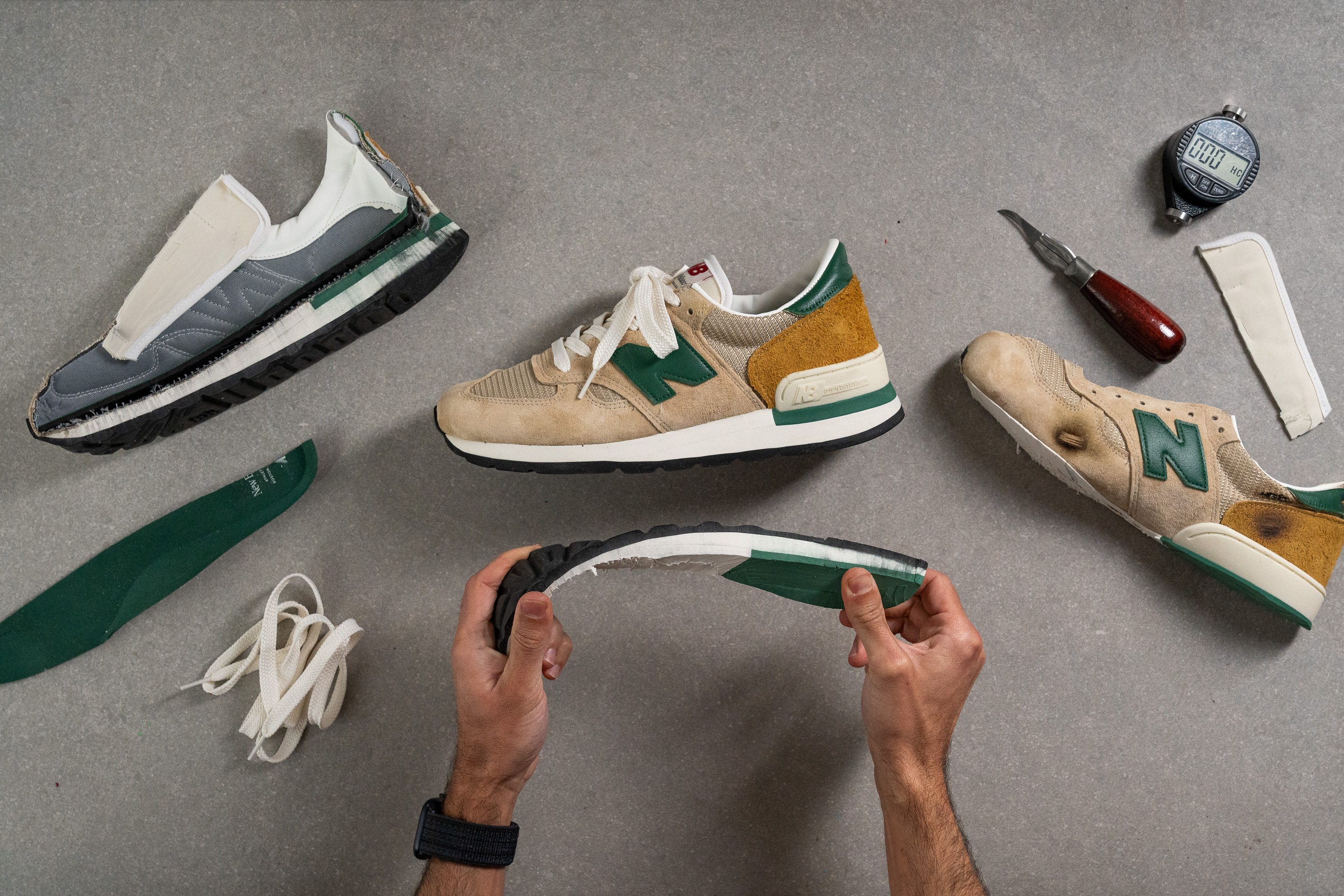
Cushioning
Heel stack
We felt rather grounded walking in the 990 v1. Unlike the more recent 990 v6 (heel stack: 39.1 mm), the first iteration keeps it real and down to earth at 34.4 mm.
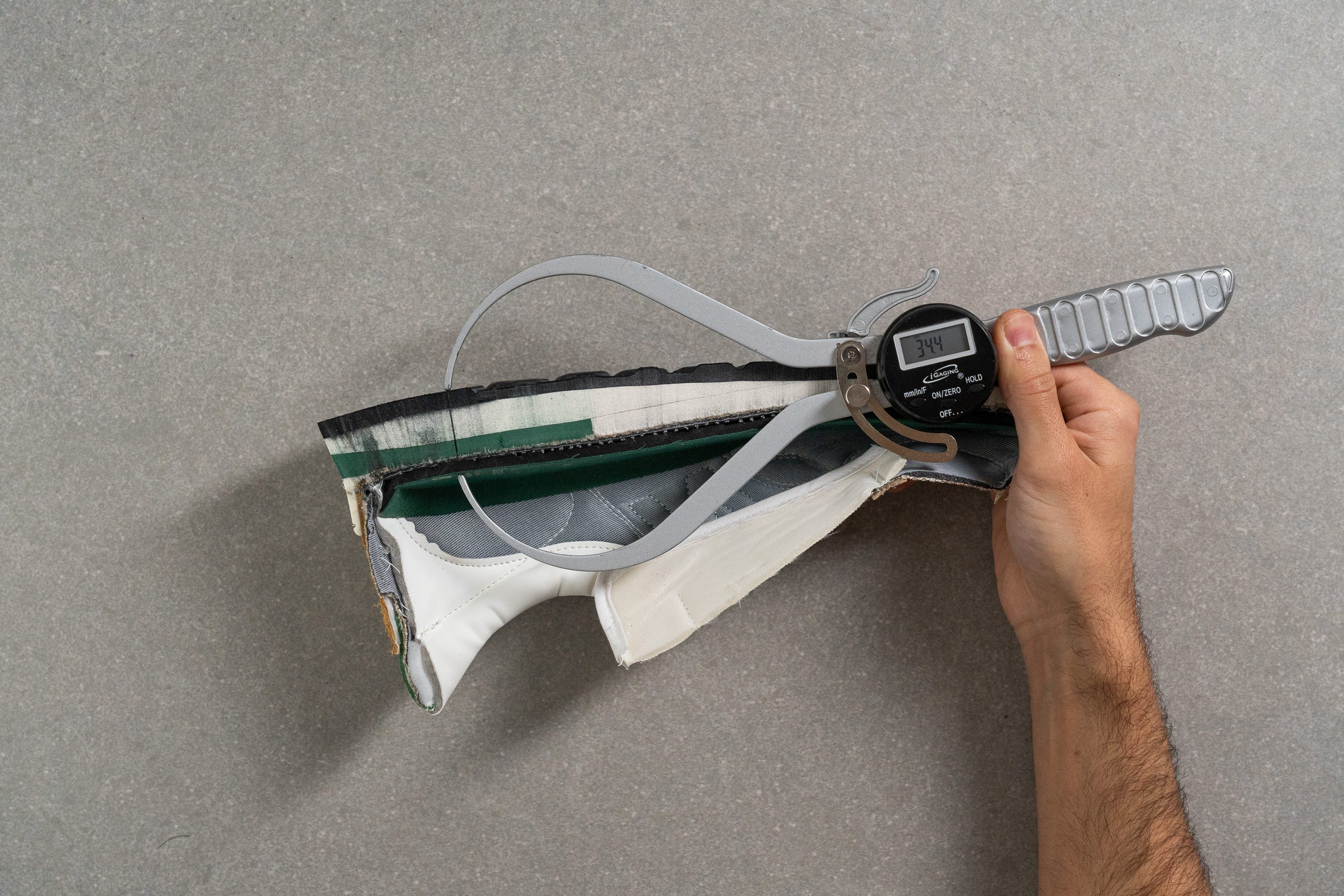
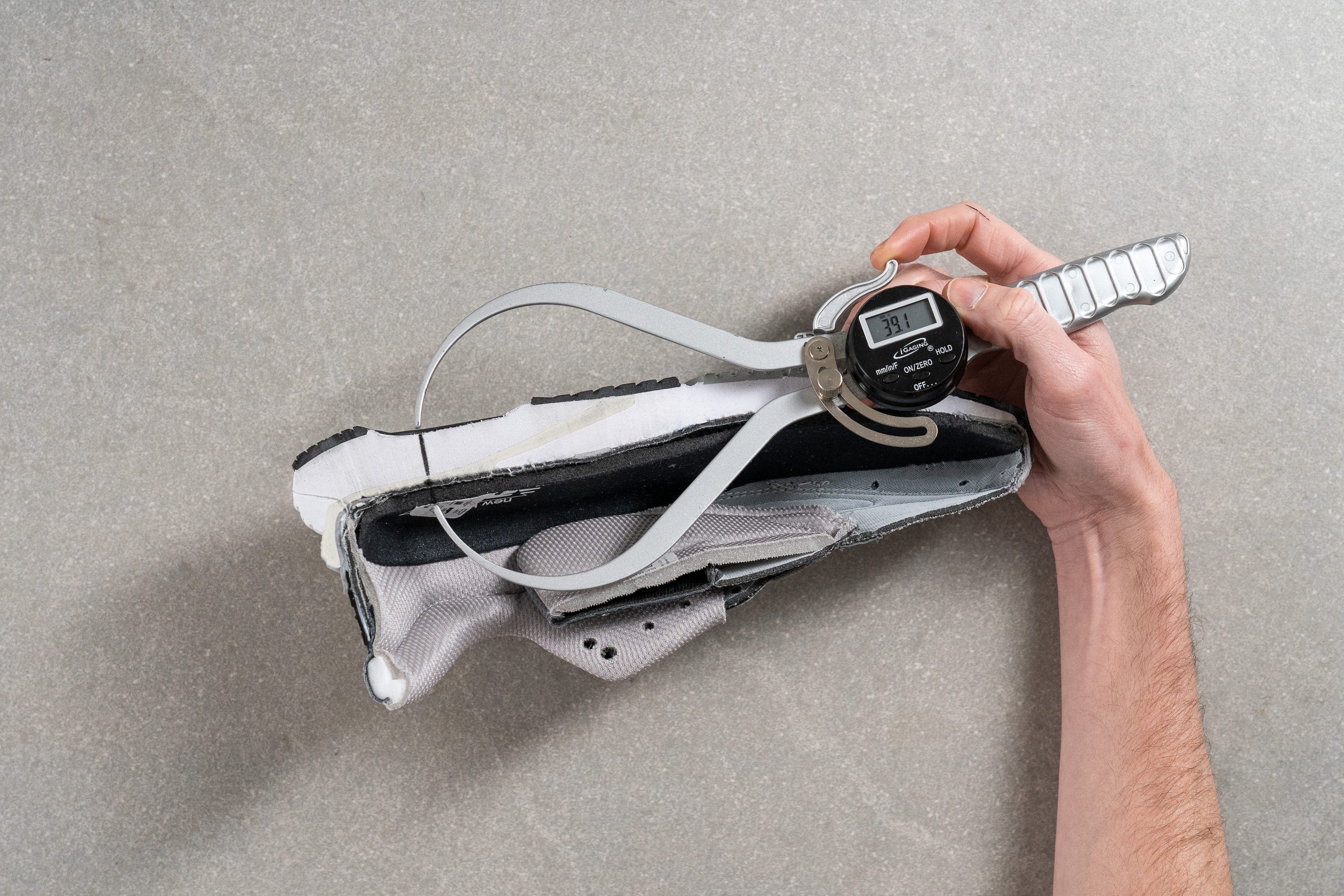
| 990 v1 | 34.4 mm |
| Average | 30.7 mm |
Forefoot stack
Under the ball of the foot, we measured the shoe's forefoot stack at 22.4 mm. This amount of cushioning is consistent with the rest of the 990 series and with the average of sneakers.
Nothing to write home about: it is comfortable and great for all-day wear.
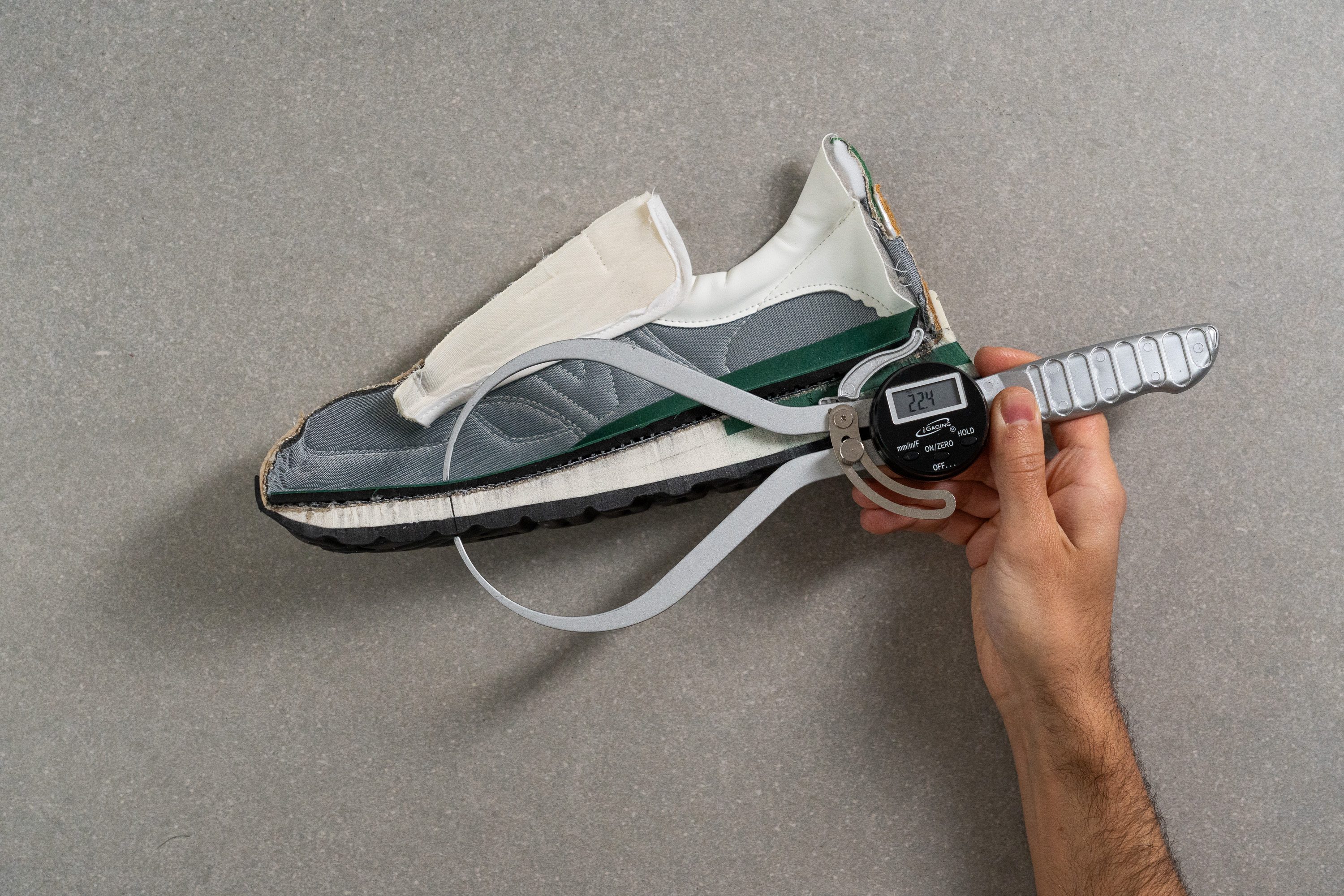
| 990 v1 | 22.4 mm |
| Average | 19.5 mm |
Drop
Inside the shoe, our feet experienced a smooth heel-to-toe drop of 12.0 mm. Because it is similar to many other sneakers, we are convinced that it won't cause any discomfort or need to adjust.
Unlike the more aggressive 15.7 mm drop of the NB 550. That one works for people who enjoy the feeling of elevated heels in their shoes.
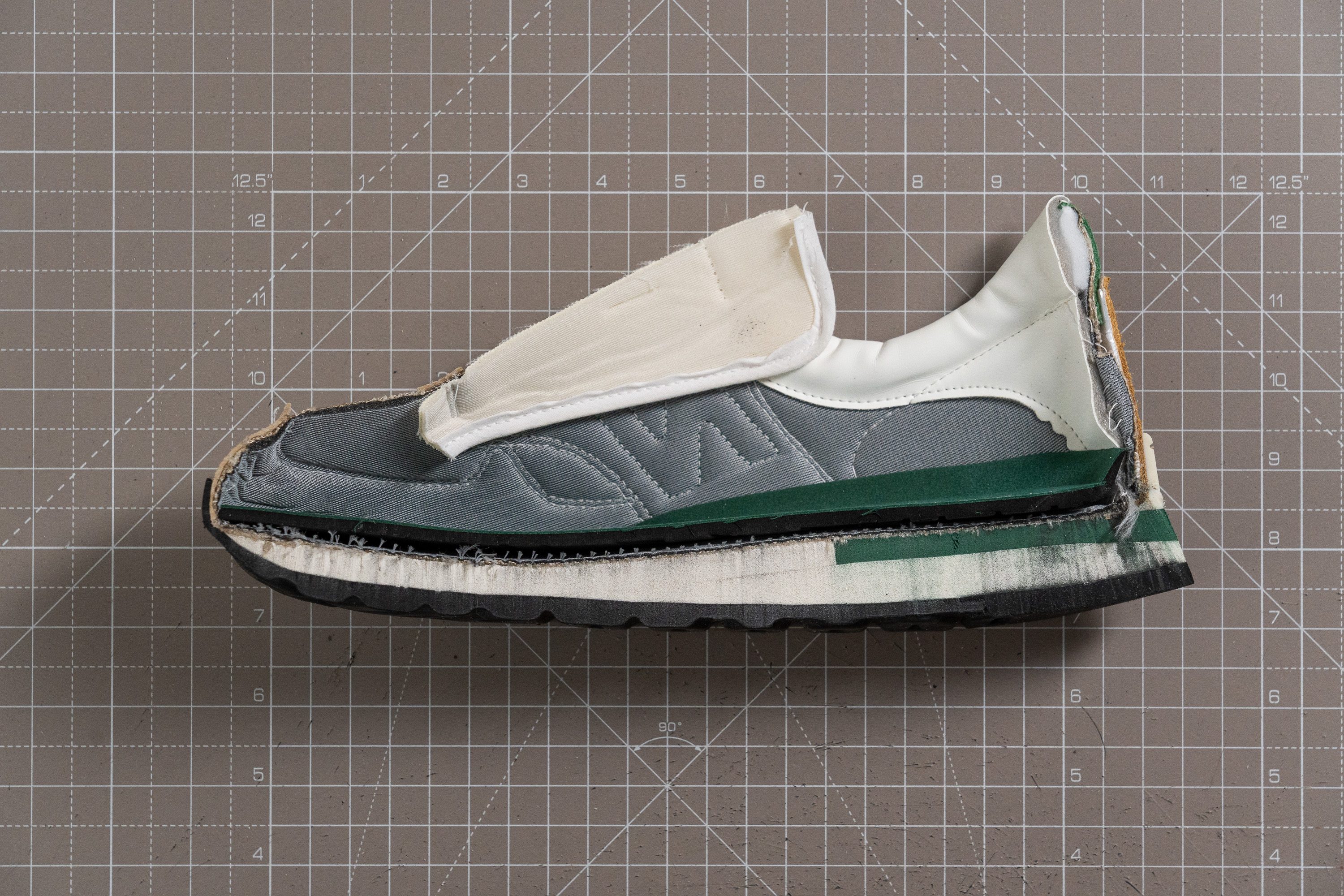
| 990 v1 | 12.0 mm |
| Average | 11.2 mm |
Midsole softness
Designed over 40 years ago, the 990v1 features the simplest midsole by modern standards. It consists of a full-length EVA foam slab which is quite firm and doesn't have much rebound.
It wasn't until 16 years later that New Balance added the more advanced ABZORB cushioning to the 990 v2.
Using a durometer, we measured the foam at 35.0 HA which is 20% firmer than average and also the firmest among the 990 shoes.
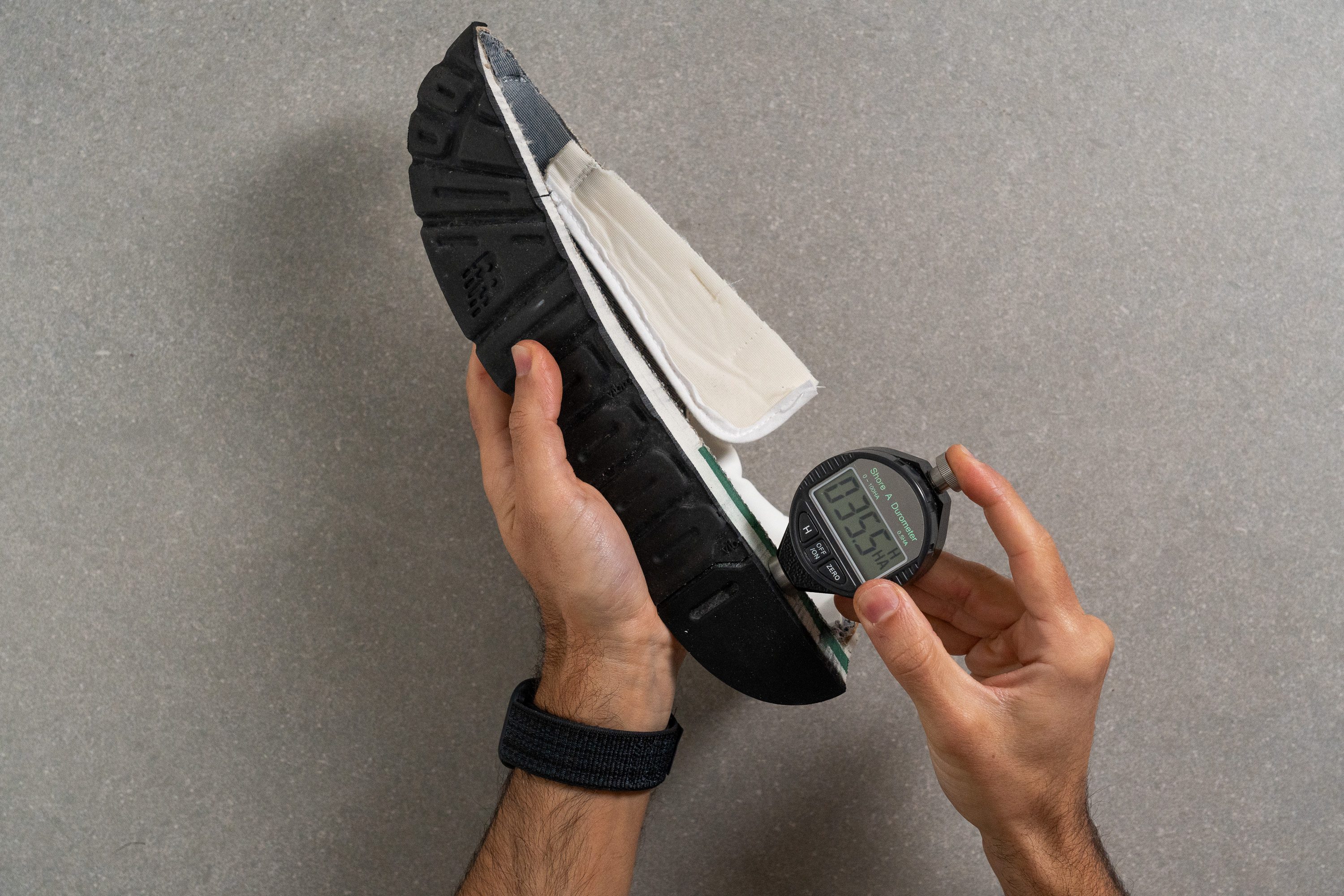
| 990 v1 | 35.0 HA |
| Average | 28.6 HA |
Secondary foam softness
In addition to primary cushioning, the 990 v1 also comes with a large heel insert made of a different-density foam. This is the historical Motion Control Device that made the headlines back in the '80s. It was designed as part of the brand's aim to create the best running shoe at the time.
Our durometer shows that this insert is even firmer than the main foam, at 42 HA. Having worn the shoe out and about, we can confirm that it plays its part in stabilizing the foot rather well.
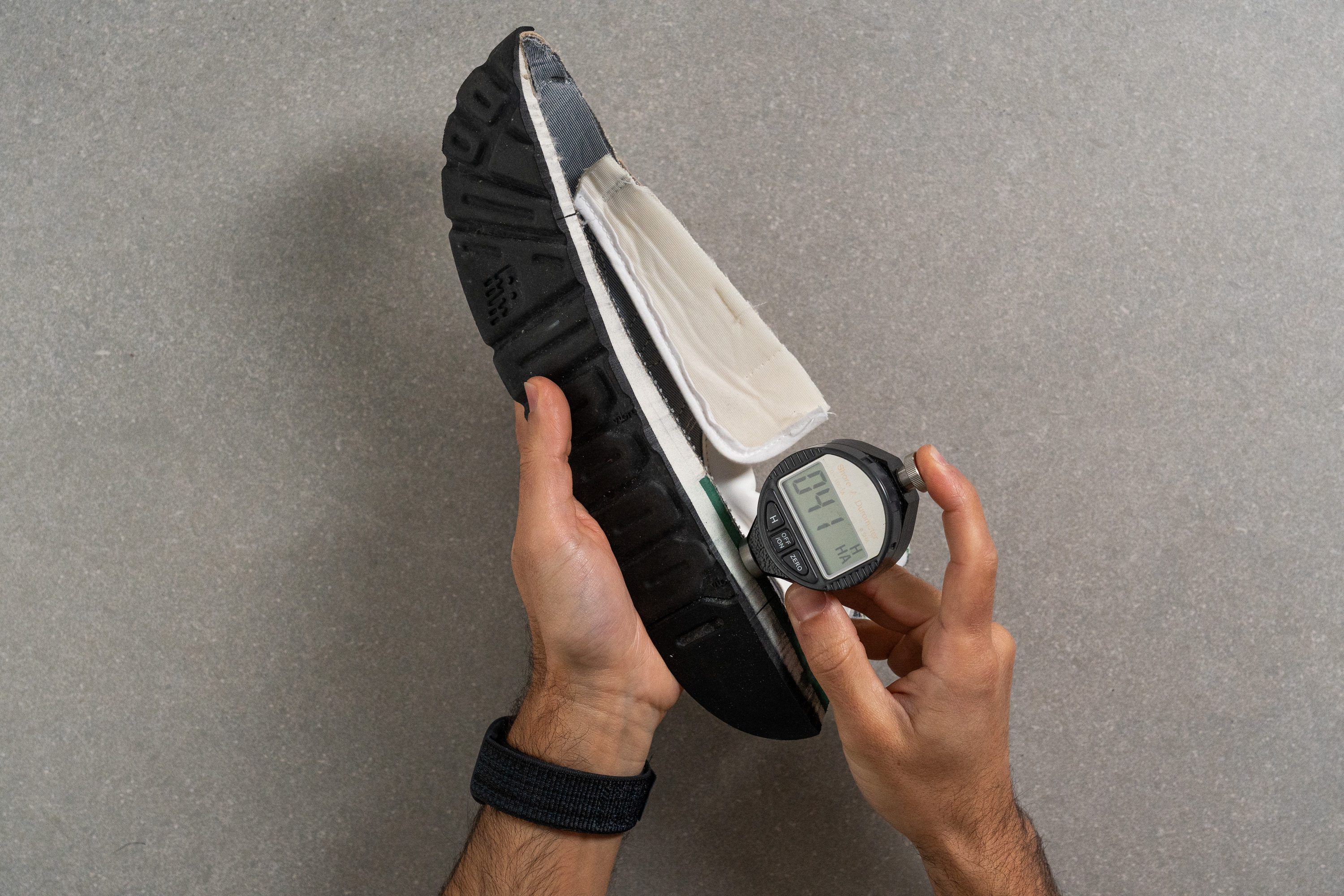
| 990 v1 | 42.0 HA |
| Average | 31.5 HA |
Size and fit
Size
New Balance 990 v1 fits true to size (13 votes).
Width / Fit
New Balance has a stellar reputation for running true to size and the 990 v1 just confirmed that once again. Trying the shoe in our regular men's US size 9 felt like matching two puzzle pieces.
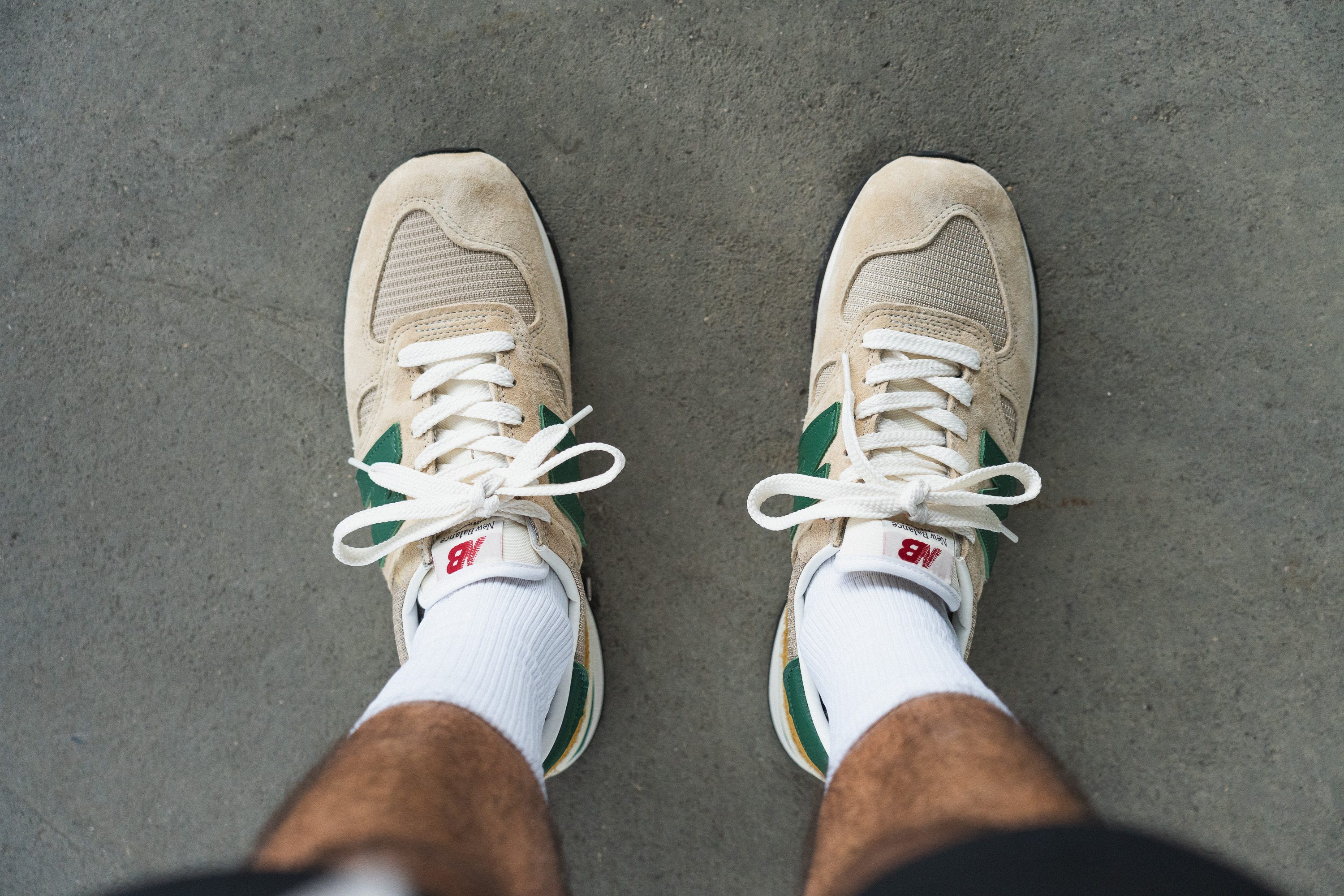
Our caliper measurements also backed up the fact that the 990 v1 has a true medium fit in the toebox. In the widest part (near the big toe joint), the tool returned 97.9 mm which is right at the average of all the sneakers we tested in the US size 9.
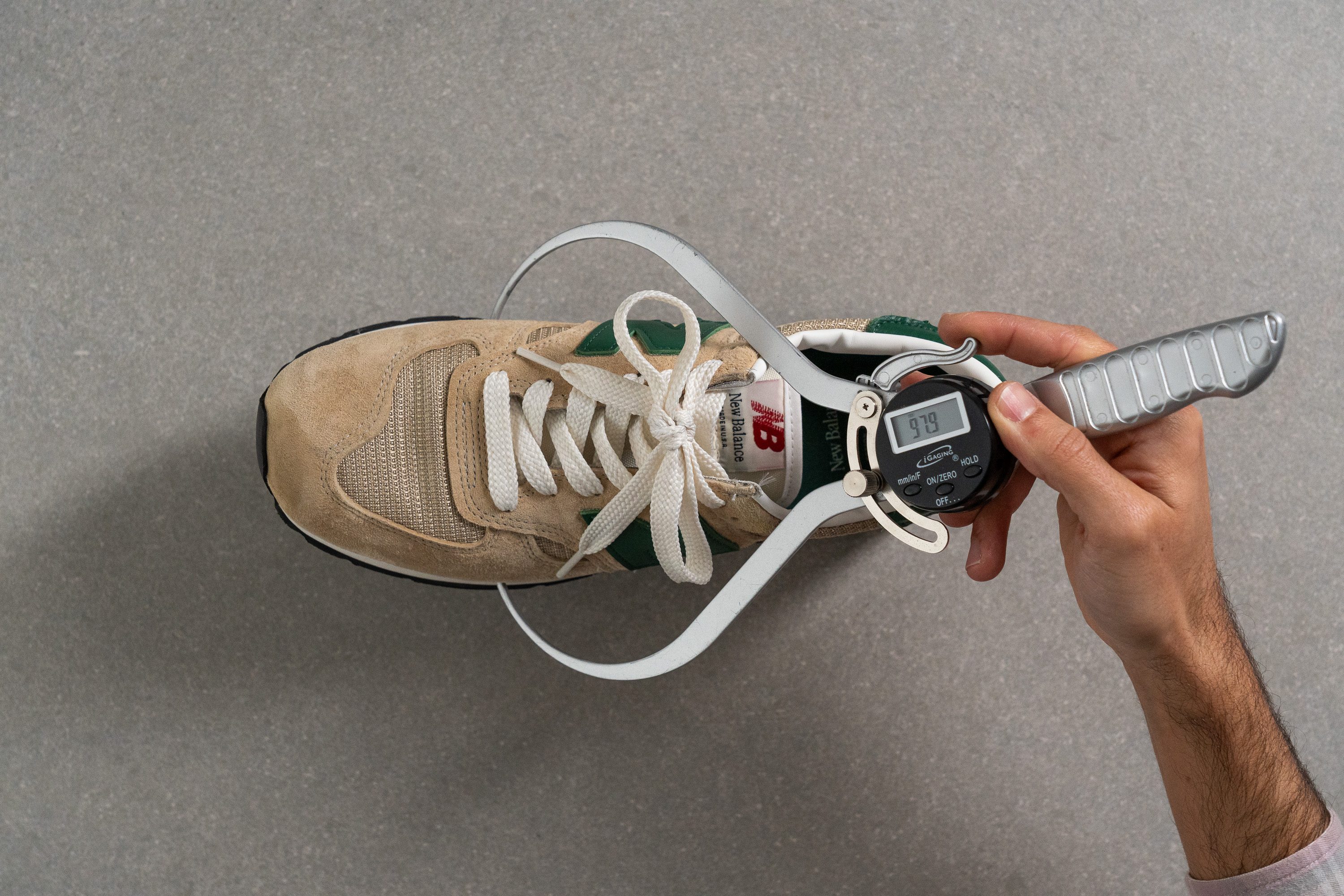
This test follows an older methodology, which is why you don't see recently tested shoes in the chart. Results from different methodologies can not be compared.
| 990 v1 | 97.9 mm |
| Average | 99.0 mm |
Toebox width
This NB sneaker also remains quite spacious around the toes. Measuring its width closer to the tip, the caliper showed 74.8 mm. Another perfectly average measurement.
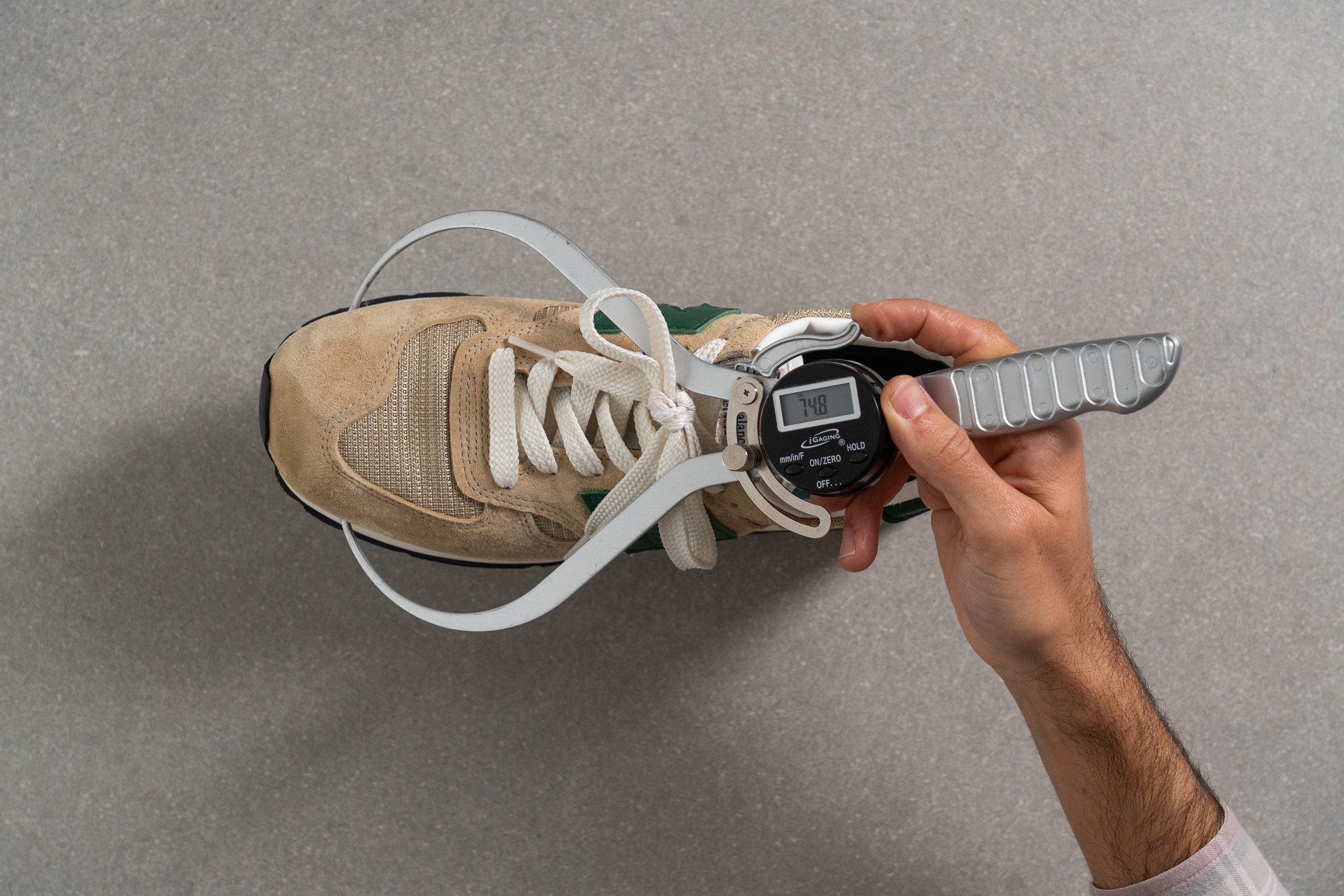
This test follows an older methodology, which is why you don't see recently tested shoes in the chart. Results from different methodologies can not be compared.
| 990 v1 | 74.8 mm |
| Average | 75.0 mm |
Flexibility / Stiffness
Given the shoe's firm midsole and overall sturdy design, we expected nothing less than a stiff, unforgiving platform. And yet, we were pleasantly surprised to experience a decent flex in the forefoot of the 990 v1.
Even though it didn't give as much freedom of movement as some other sneakers, the shoe had enough bend to accommodate smooth heel-to-toe transitions.
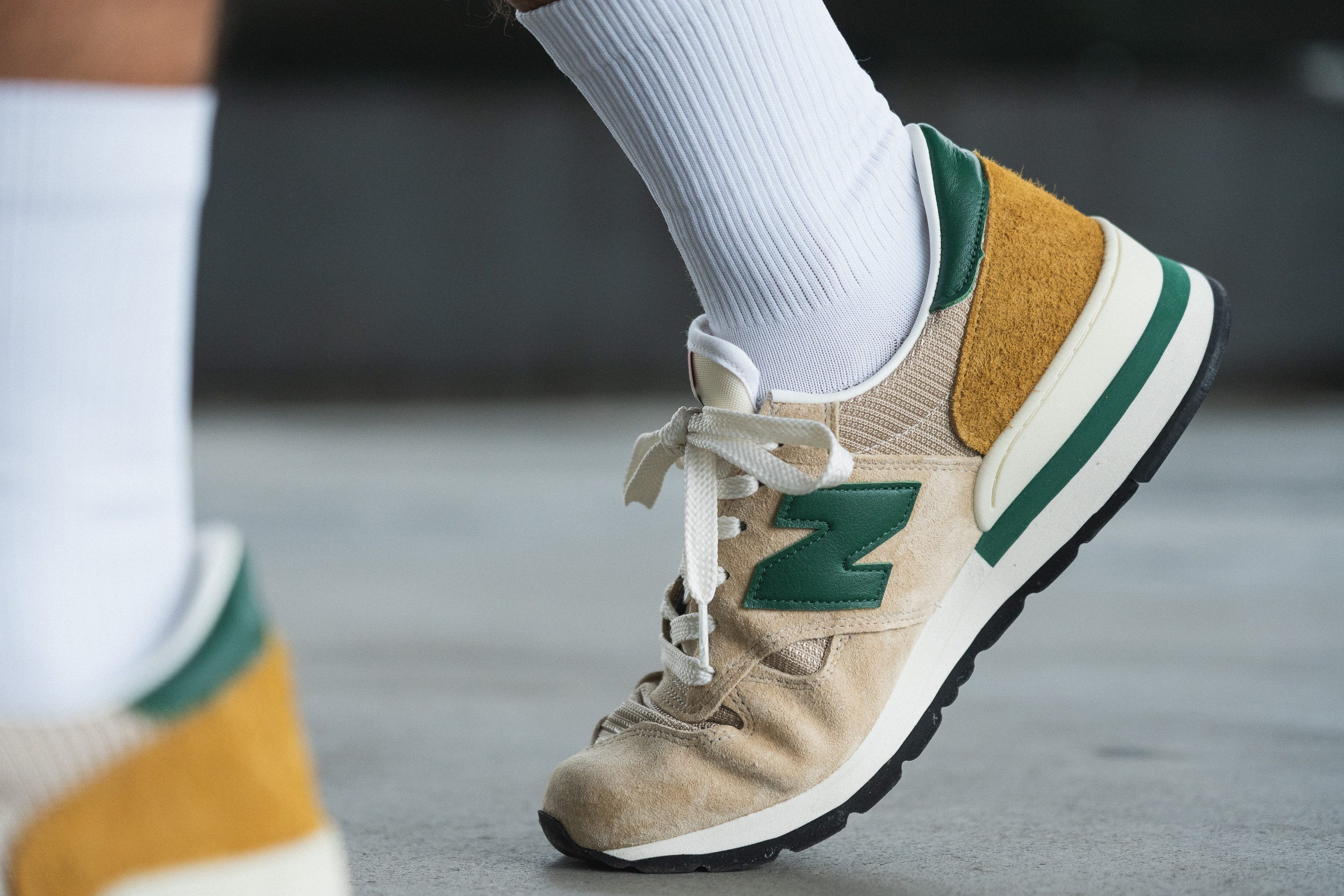
Our in-house flexibility test showed that it takes 25.4N to bend this NB shoe to a 90-degree angle. That is 13% stiffer than average and can be on the edge of uncomfortable for some folks. For reference, its stiffness is very close to the famous New Balance 550 (25.9N).
This test follows an older methodology, which is why you don't see recently tested shoes in the chart. Results from different methodologies can not be compared.
| 990 v1 | 25.4N |
| Average | 23.3N |
Weight
Admittedly, New Balance sneakers are not the lightest bunch. And we are not even mentioning the 22.6 oz monster CT302.

But with the 990 v1, your legs can catch a break as it comes in at a moderate 12.9 oz (366g). That's even an ounce lighter than average!

| 990 v1 | 12.9 oz (366g) |
| Average | 13.8 oz (390g) |
Breathability
Hold off calling it your summer sneaker just yet - the NB 990 v1 is the least breathable shoe in the series!
As an old-fashioned kick, the proportion of mesh and suede in its upper tilts more towards the latter. We could feel the heat building up on a warm day, threatening with an unpleasant odor.
Even the mesh panels didn't do much, based on our in-house breathability test. The small gaps between the tongue and the upper are the only way for the heat to escape.
As we hover the shoe's half-cut upper over the light, we see no hope for ventilation anywhere outside of the tongue. Thus, the 990 v1 gets a lower score of 3 out of 5.
We went as far as checking the kick's mesh material under the microscope.
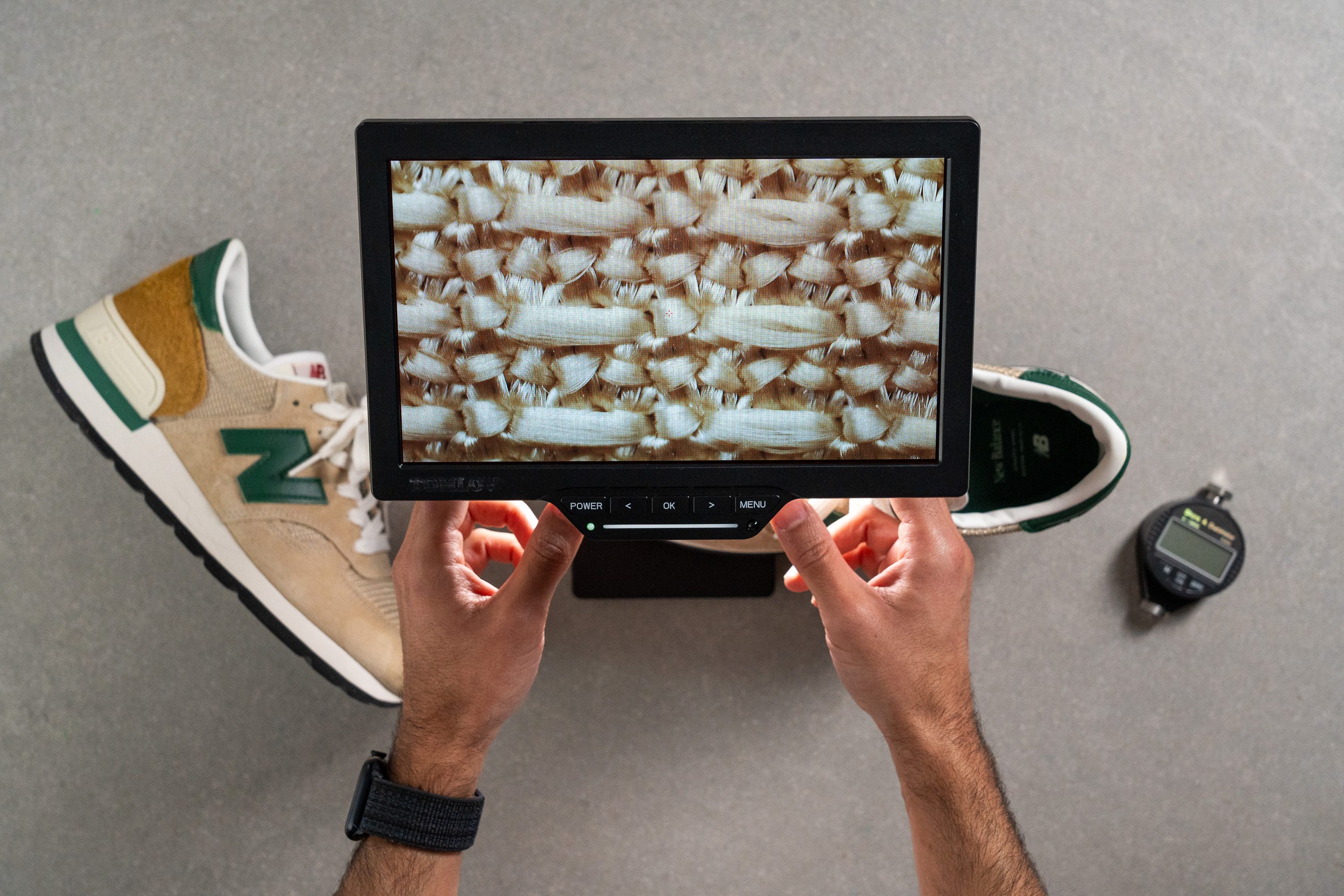
Kinda hard to call it mesh after seeing this textile up close. Thick threads and dense weave make up a pretty sturdy yet heat-trapping material.
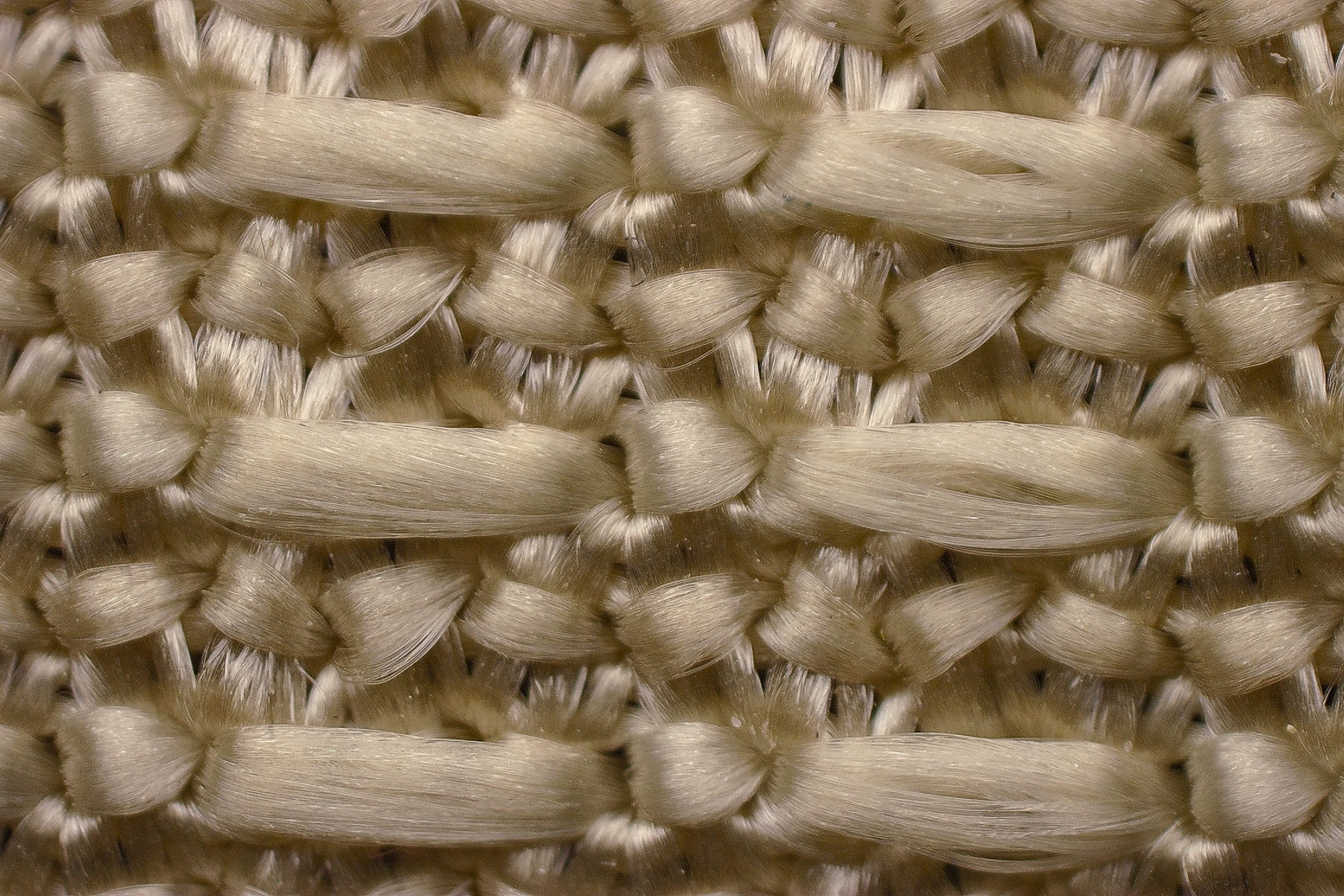
If you're after a 990 sneaker that can be donned on a hot summer day, the 990 v6 has fantastic ventilation with the highest breathability score: 5 out of 5!
| 990 v1 | 3 |
| Average | 3 |
Stability
Lateral stability test
Getting a New Balance sneaker nearly always translates into getting a very supportive and stable shoe.
Originally intended as a motion-control running shoe, the 990 v1 carries over its supportive properties into a lifestyle sneaker that can be recommended to people with overpronation.
Torsional rigidity
Choosing a firm foam for its midsole, the 990 v1 contributes to the stability department.
As our manual test shows, twisting this sneaker takes some effort. On a 1-5 scale, where 5 is the stiffest, we readily give it a solid 4.
A rigid platform like that lowers the risk of rolling your ankles over the edge of the sole.
| 990 v1 | 4 |
| Average | 3.6 |
Heel counter stiffness
With New Balance's famous heel clip and a fairly structured heel counter, we got a very secure hold in the rearfoot.
Assessing the shoe's heel counter stiffness from 1 to 5, we believe that it is worthy of the higher 4.
Our ankles stayed securely locked inside the 990 v1's heel cup and there was not a hint of heel slippage. The only gripe we have with this part of the shoe is that the synthetic lining feels a bit sticky against the skin causing slight chafing.
| 990 v1 | 4 |
| Average | 3.2 |
Midsole width - forefoot
The nice and broad platform of the 990 v1 granted our feet with a very grounded experience.
Measuring the distance between its widest points in the forefoot, our caliper showed 109.4 mm. That's on par with most sneakers these days.
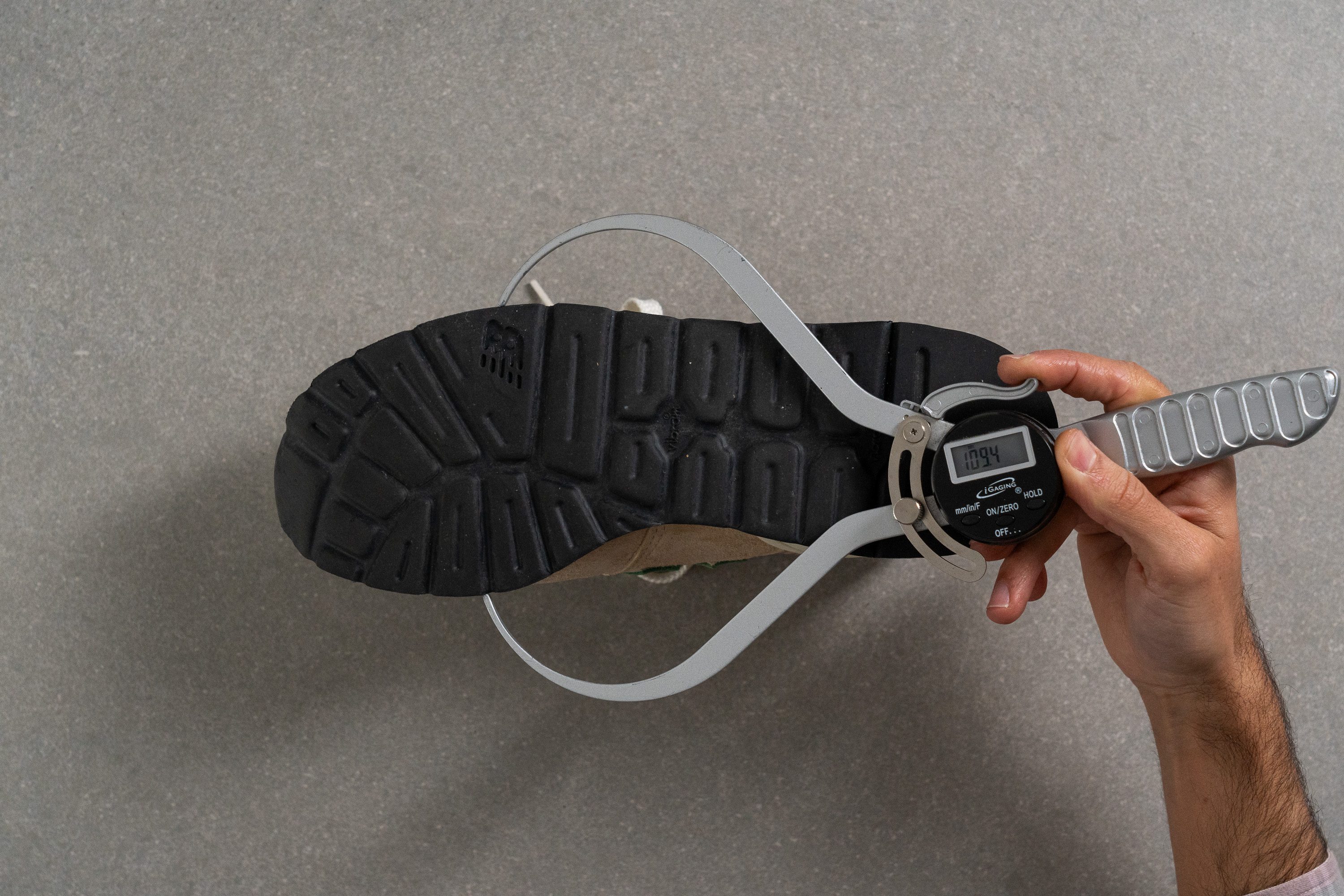
| 990 v1 | 109.4 mm |
| Average | 108.9 mm |
Midsole width - heel
It is in the heel that the 990 v1 flares out wider than most shoes. With a caliper measurement of 89.2 mm, it is among the widest bases in our catalog.
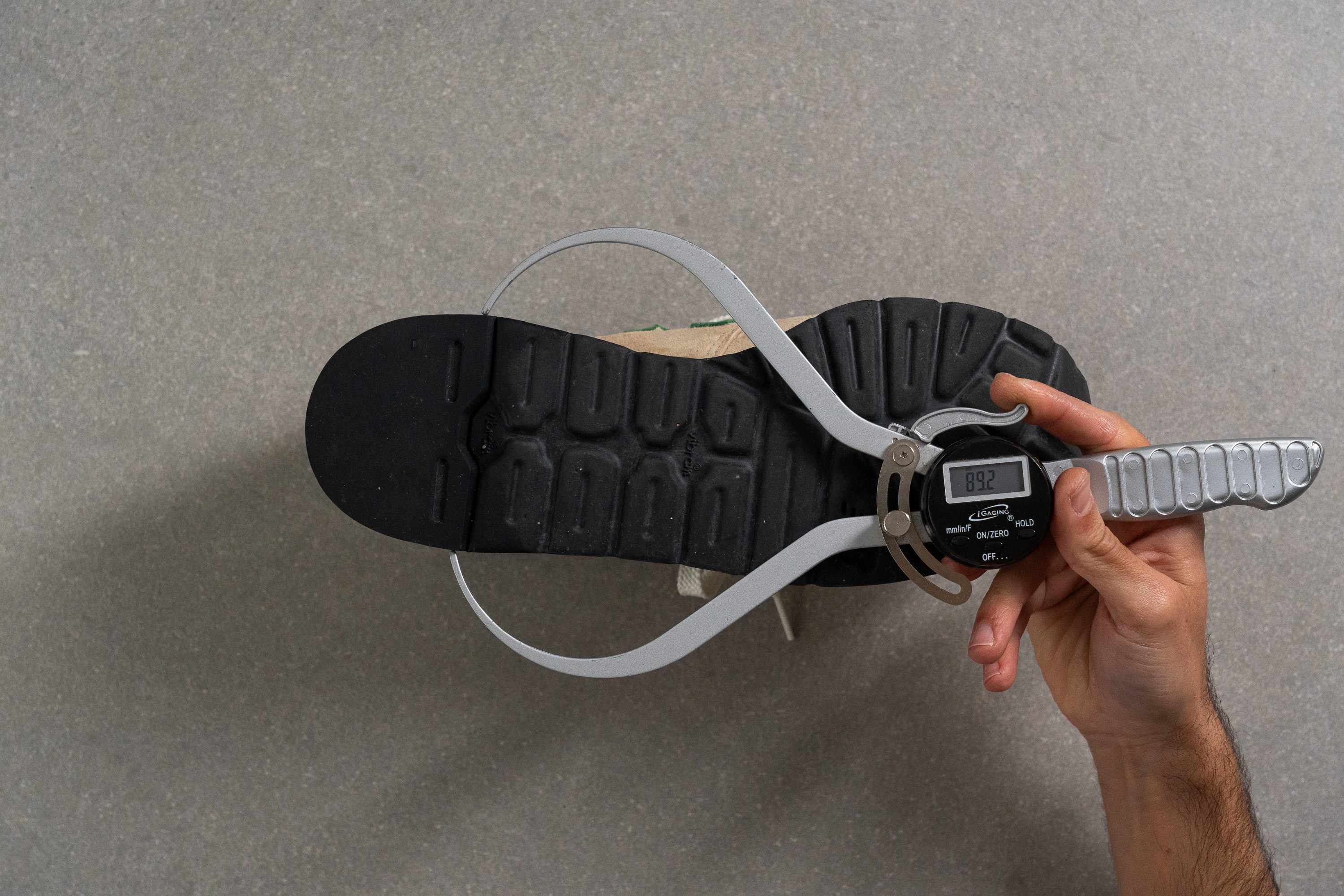
Every step felt planted and surefooted in this New Balance kick.
| 990 v1 | 89.2 mm |
| Average | 84.0 mm |
Durability
Leather/Suede quality
The 990 v1's dazzling success back in the '80s was partially explained by the fact that it was manufactured domestically, in the United States, using the most high-quality materials.
Today, we check whether the sneaker stays true to its promises.
Equipped with a butane torch and a leather scratch awl, we set out to test the suede and leather patches throughout the shoe's upper.
From the heel to the toebox, this NB shoe kept checking off our boxes.
Check. Check. Check.
Stop. The only fake leather part is found inside the shoe's heel counter.
| 990 v1 | Real suede |
Toebox durability
Admit it, you too can't help smelling a freshly bought pair of kicks.
Let us assure you that the 990 v1 exudes the most luxurious fragrance of an expensive suede shoe. And it certainly proves its worth in close contact with our sandpaper Dremel tip.
Applying the tool to the suede-covered toebox for 12 seconds at a demanding speed of 5K RPM, we were highly satisfied with the result. A small cosmetic dent on the material is not even seen from afar!
This earns the NB 990 v1 a solid 4 out of 5 score for toebox durability. This pricey pair is not afraid of being worn day in and day out.
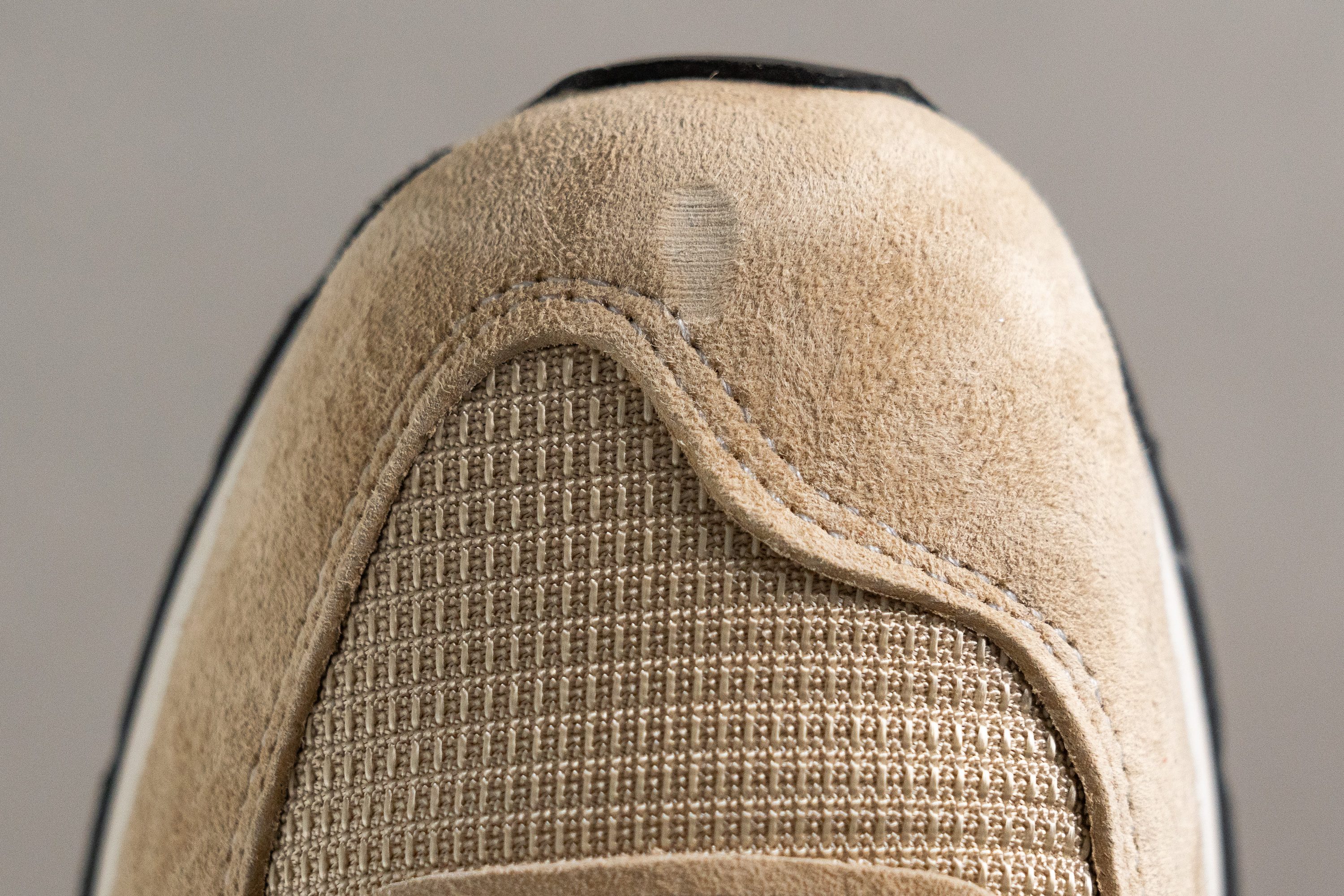
| 990 v1 | 4 |
| Average | 3.7 |
Heel padding durability
Neither will you see premature wear on the shoe's heel padding. Even though it is such a delicate area, our Dremel had a really hard time damaging it.
In most sneakers, it takes a mere touch of a Dremel to tear the heel lining to the core. But 4 seconds of drilling at 5K RPM barely even left a scratch on the synthetic leather lining of this NB shoe.
This is what 5 out of 5 for heel padding durability looks like. You get what you pay for in the 990 v1!

| 990 v1 | 5 |
| Average | 3.2 |
Outsole hardness
We do have some reservations about the shoe's outsole though. It felt suspiciously soft, and that's not normally a good sign of durability.
Pressing our durometer against the rubber, the tool returned 72.9 HC which is 15% softer than the average sneaker outsole. Unfortunately, less hard rubbers also tend to wear out faster.
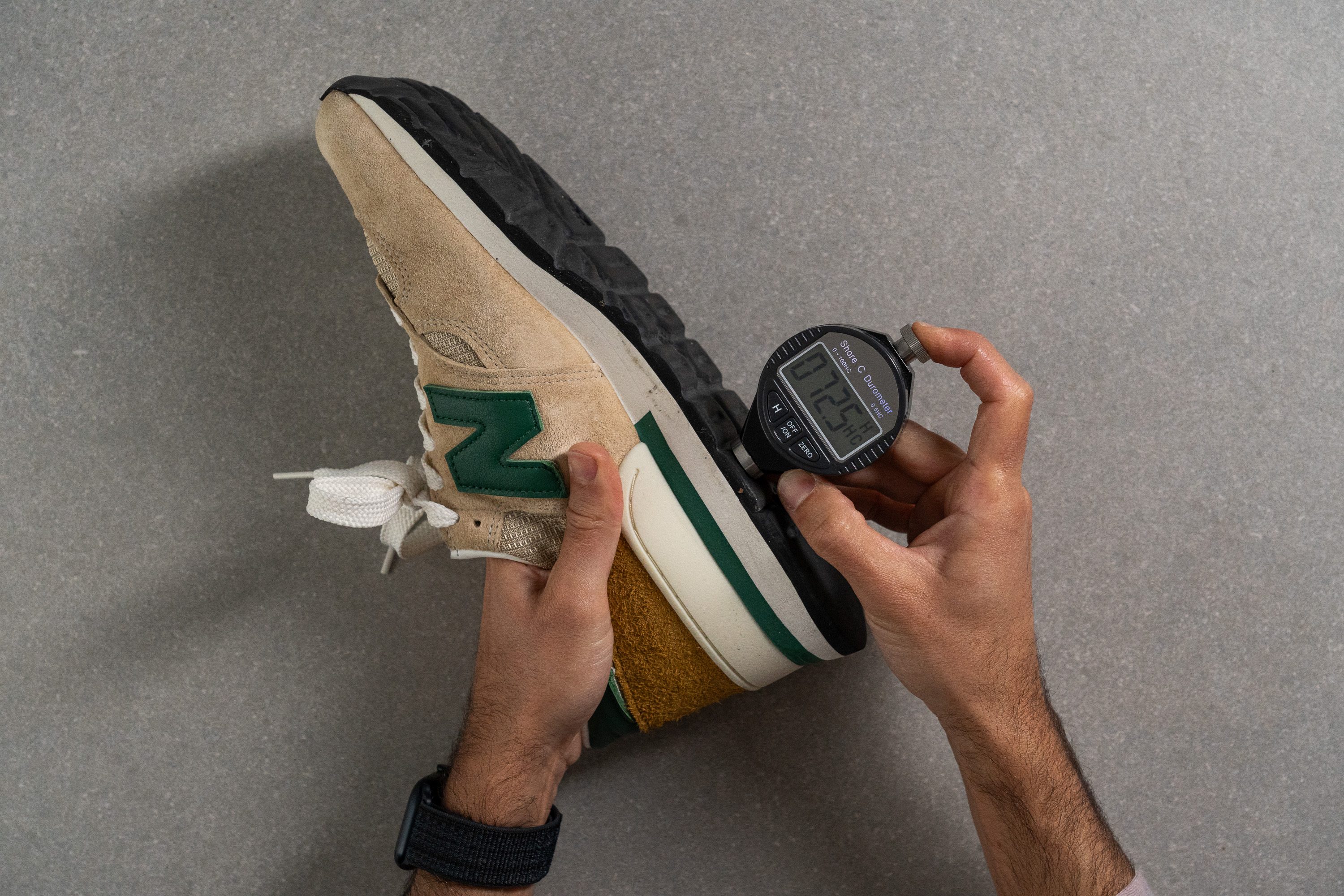
| 990 v1 | 72.9 HC |
| Average | 85.7 HC |
Outsole durability
Our worries were confirmed the very second we applied the Dremel tip to the outsole.
Apparently, not all Vibram rubbers are made equal and this one ended up melting like butter on our eyes.
We held the Dreme at a consistent speed (10K RPM) and pressure (3.2N) for 22 seconds to compare the 990 v1's abrasion resistance (or lack thereof).
Even before we measured the dent with a tread gauge, we could see that it was much deeper than the average one. Indeed, at a whopping 3.06 mm, it is among the deepest in our roster. It is almost as if there was no rubber and the shoe had exposed foam only.

| 990 v1 | 3.1 mm |
| Average | 1.1 mm |
Outsole thickness
But here is some reassuring news - the NB 990 v1 has some of the thickest slabs of rubber among sneakers. Based on our caliper, this outsole is 7.5 mm thick!
It may be soft and quick to wear but at least there is plenty of rubber to go through before the shoe calls it a day.
But if you are still uneasy about it, have a look at the succeeding versions of the 990 starting from v3 that feature the brand's Ndurance rubber.
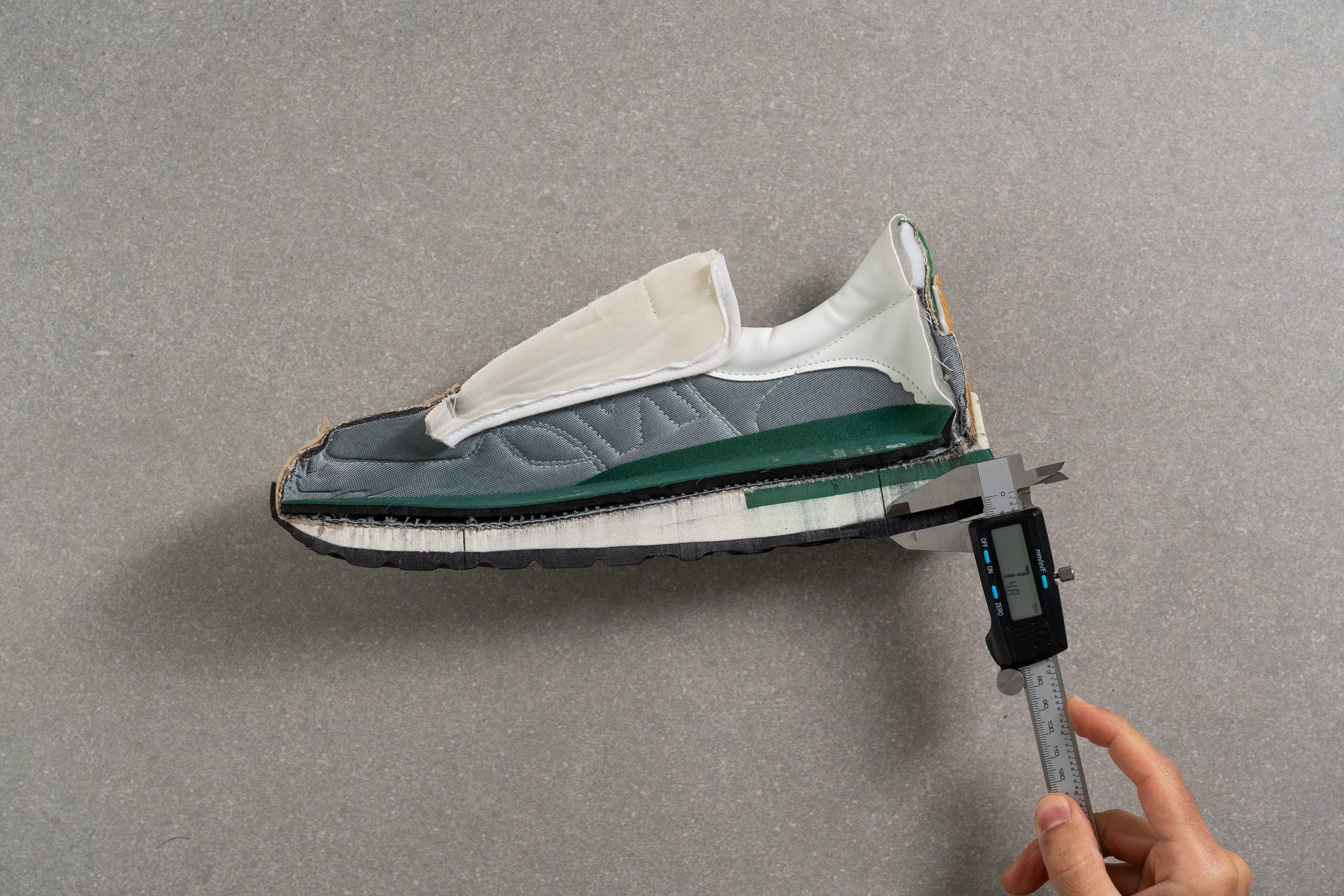
| 990 v1 | 7.5 mm |
| Average | 5.3 mm |
Misc
Insole thickness
Helping the 990 v1 feel cozier underfoot is a thick 5-mm insole. With a bit of plushness to it, this insert does a great job buffering the midsole firmness.
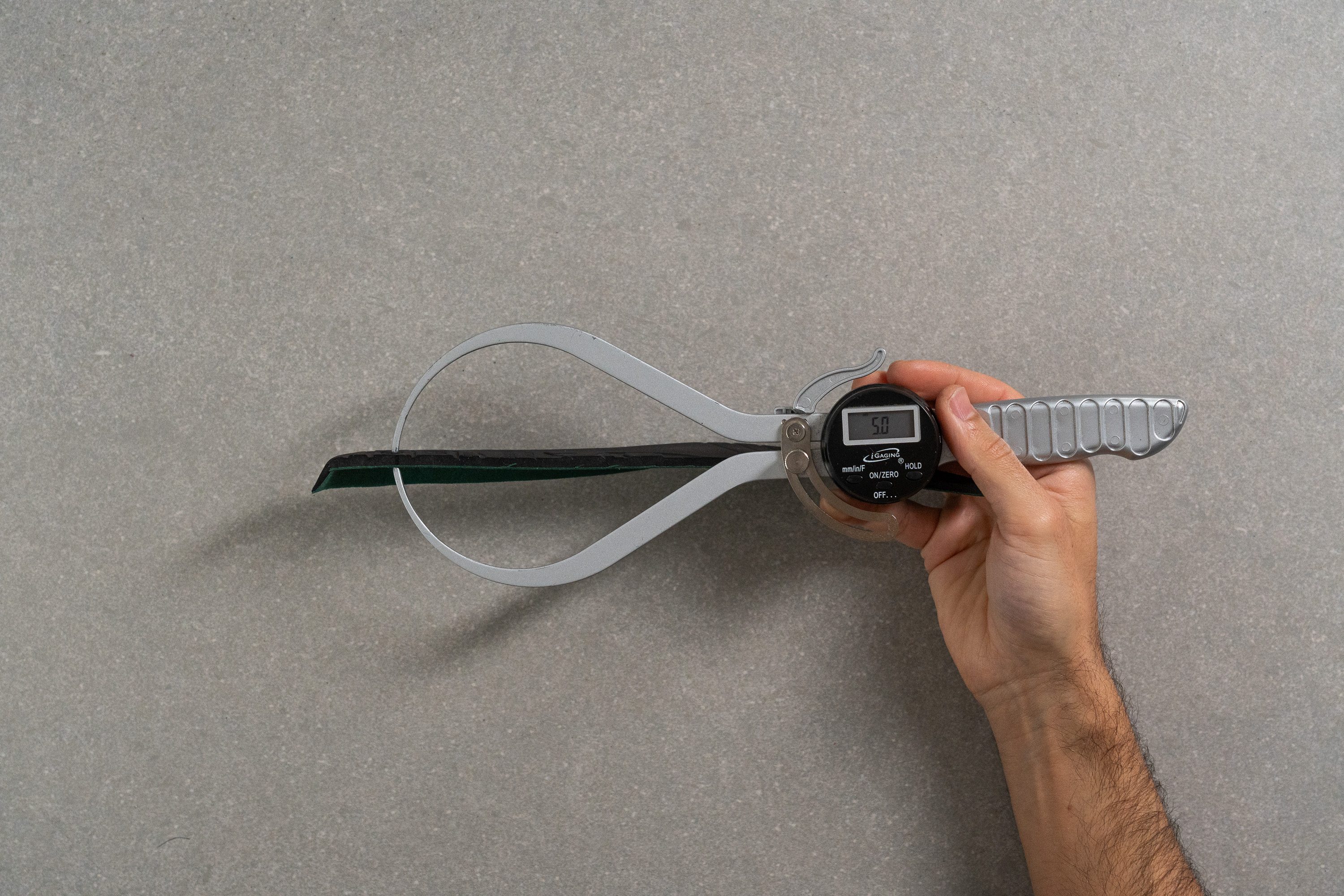
| 990 v1 | 5.0 mm |
| Average | 5.1 mm |
Removable insole
Some people may want to level up the shoe's basic-feeling cushioning with a plusher insert. That is easily done by removing the stock insole.

| 990 v1 | Yes |
Reflective elements
As it turns out, the NB 990 v1 was not intended for low-light conditions. So it doesn't help you be more visible in the dark...unless that's what you aim for.
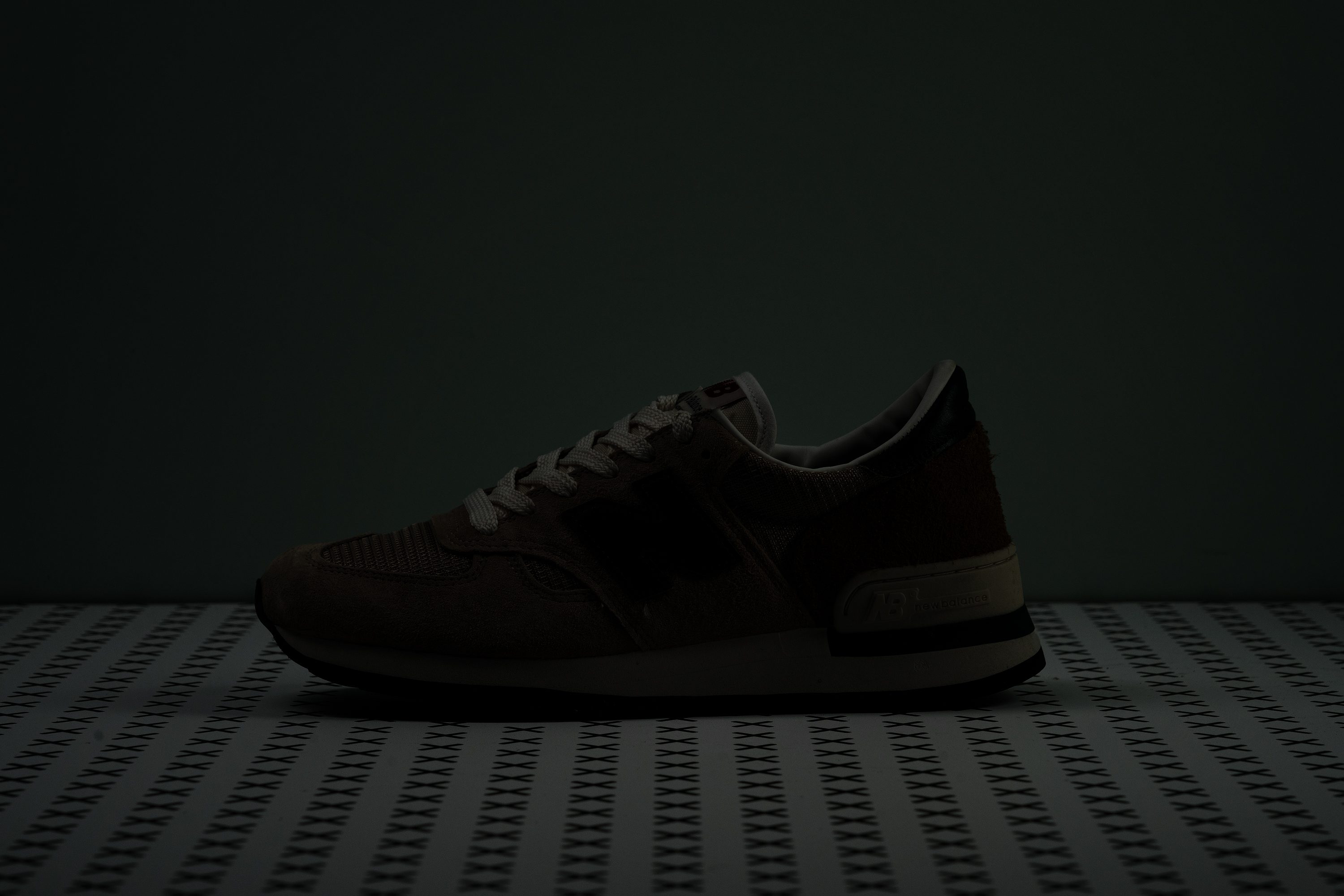
| 990 v1 | Yes |
Tongue padding
Compared to other iterations of the 990, the v1's tongue is paper-thin! We measured it at only 2.5 mm compared to the puffy 10-12.5 mm of the succeeding versions.
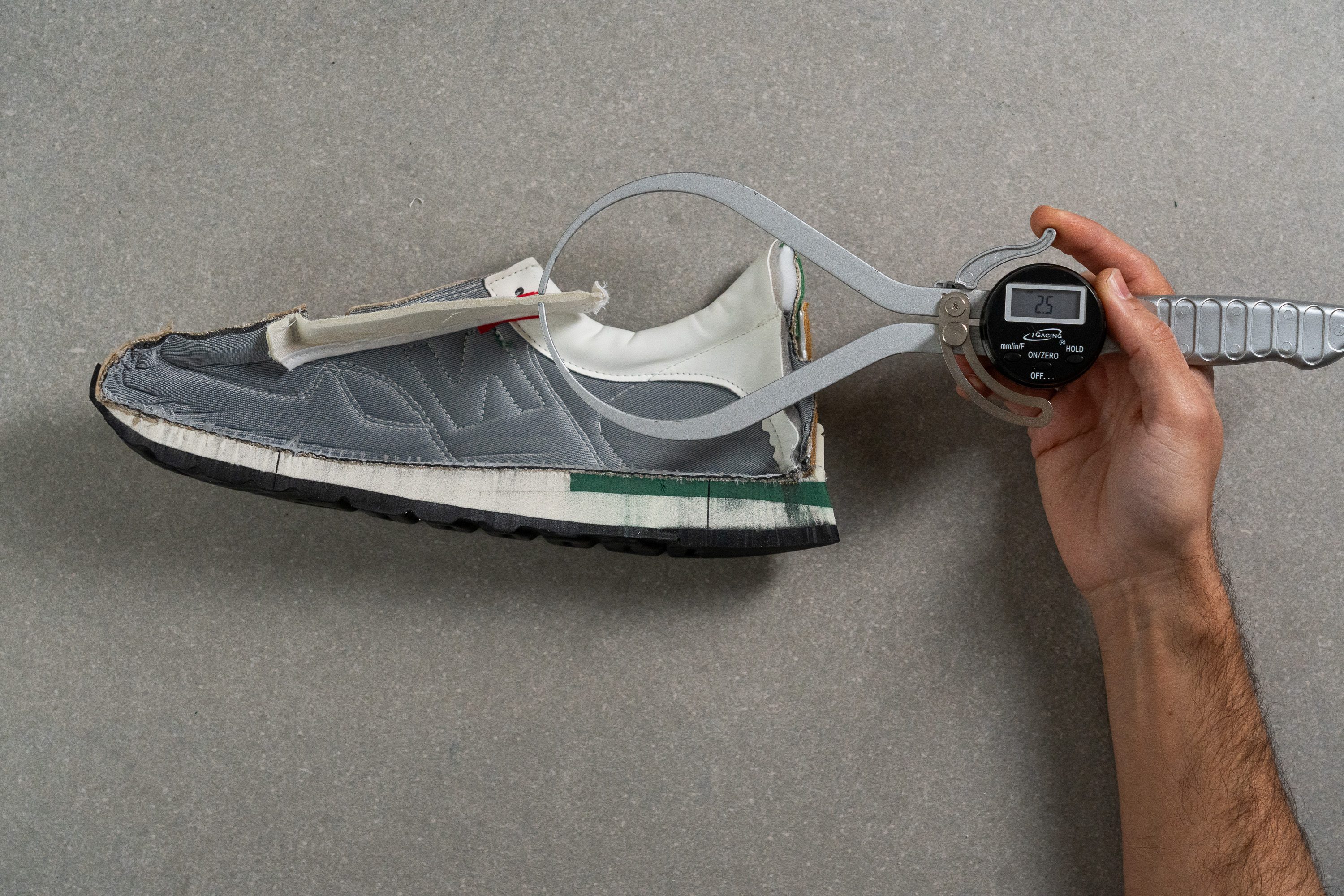
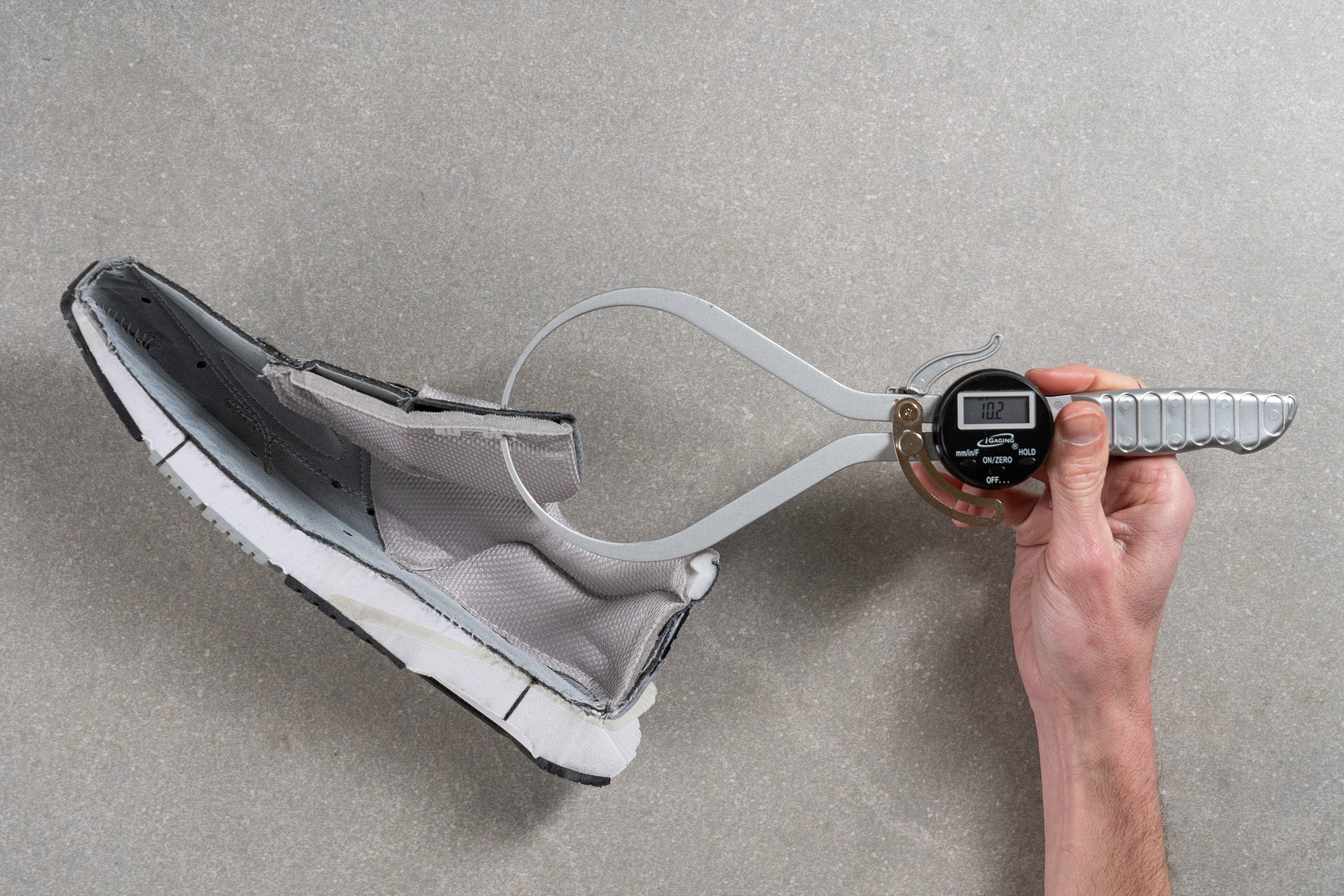
Another important thing to note about the v1 is that it doesn't have much internal padding as a whole. Its upper sits pretty close against the foot.
| 990 v1 | 2.5 mm |
| Average | 9.6 mm |
Tongue: gusset type
The tongue of this NB shoe has no gussets on the sides. But they are absolutely unnecessary given its wide and ergonomic shape.
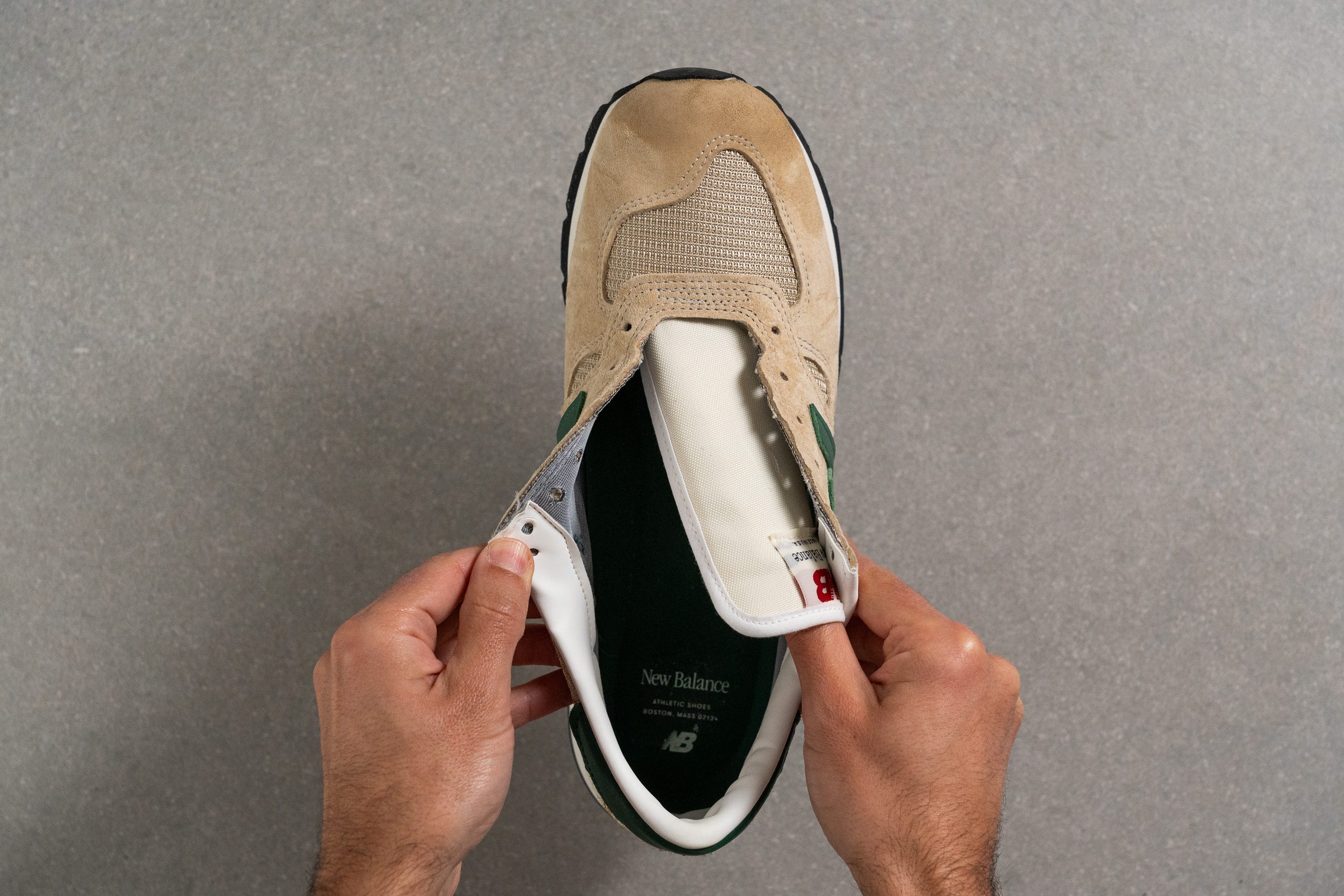
| 990 v1 | None |
Heel tab
No pull tabs over here but the slightly raised heel collar aids in getting the shoe on.
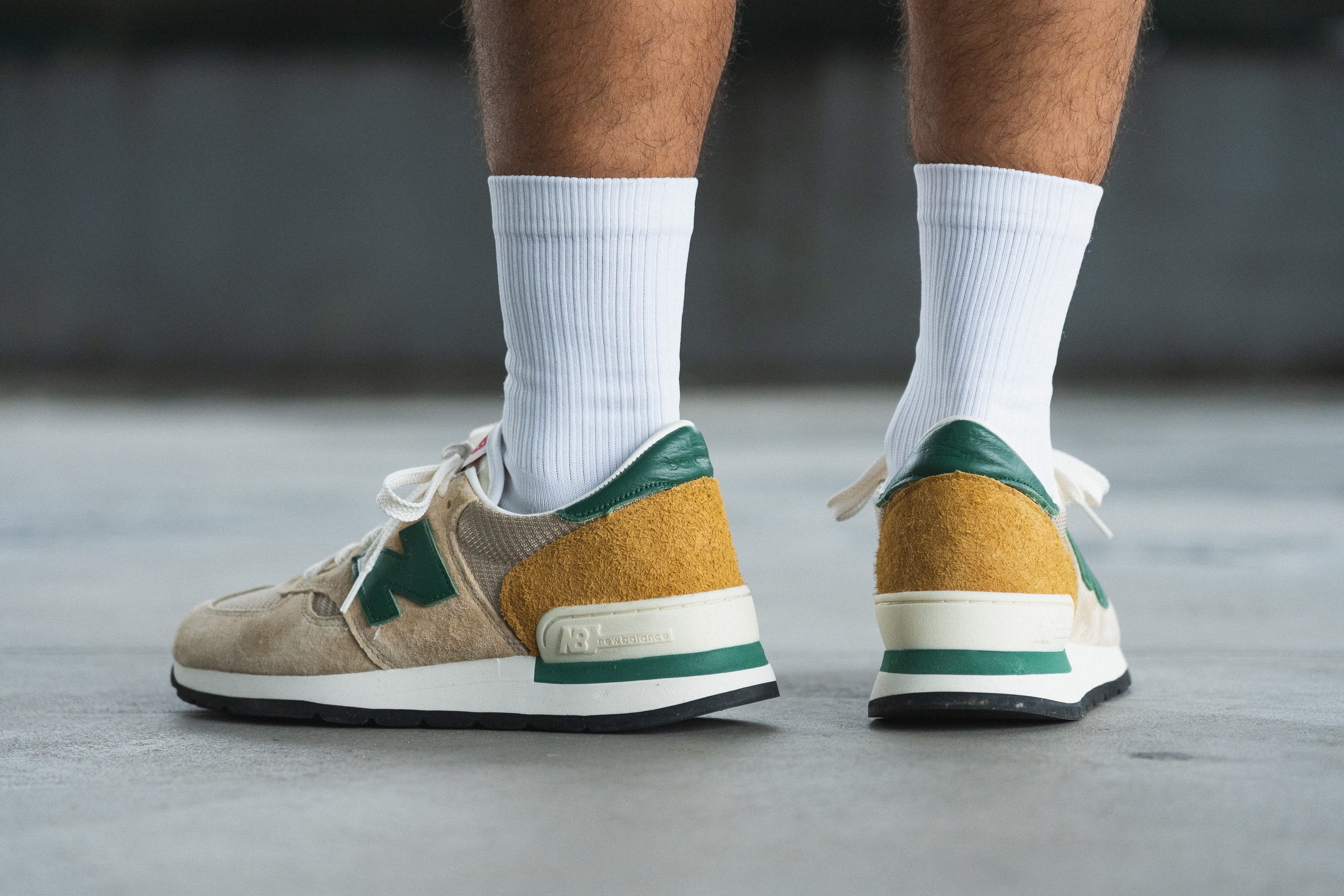
| 990 v1 | None |
Back to 1982: the story behind the 990
Introduced in 1982 as the most technologically sophisticated running shoe at that time, the 990 v1 took over 3 years to design.
The kick retailed with a hefty price tag of $100 which, adjusted for inflation, would cost more than $300 today! But even being one of the most expensive shoes back then did not stop the 990 from selling out ten times beyond its projected sales.
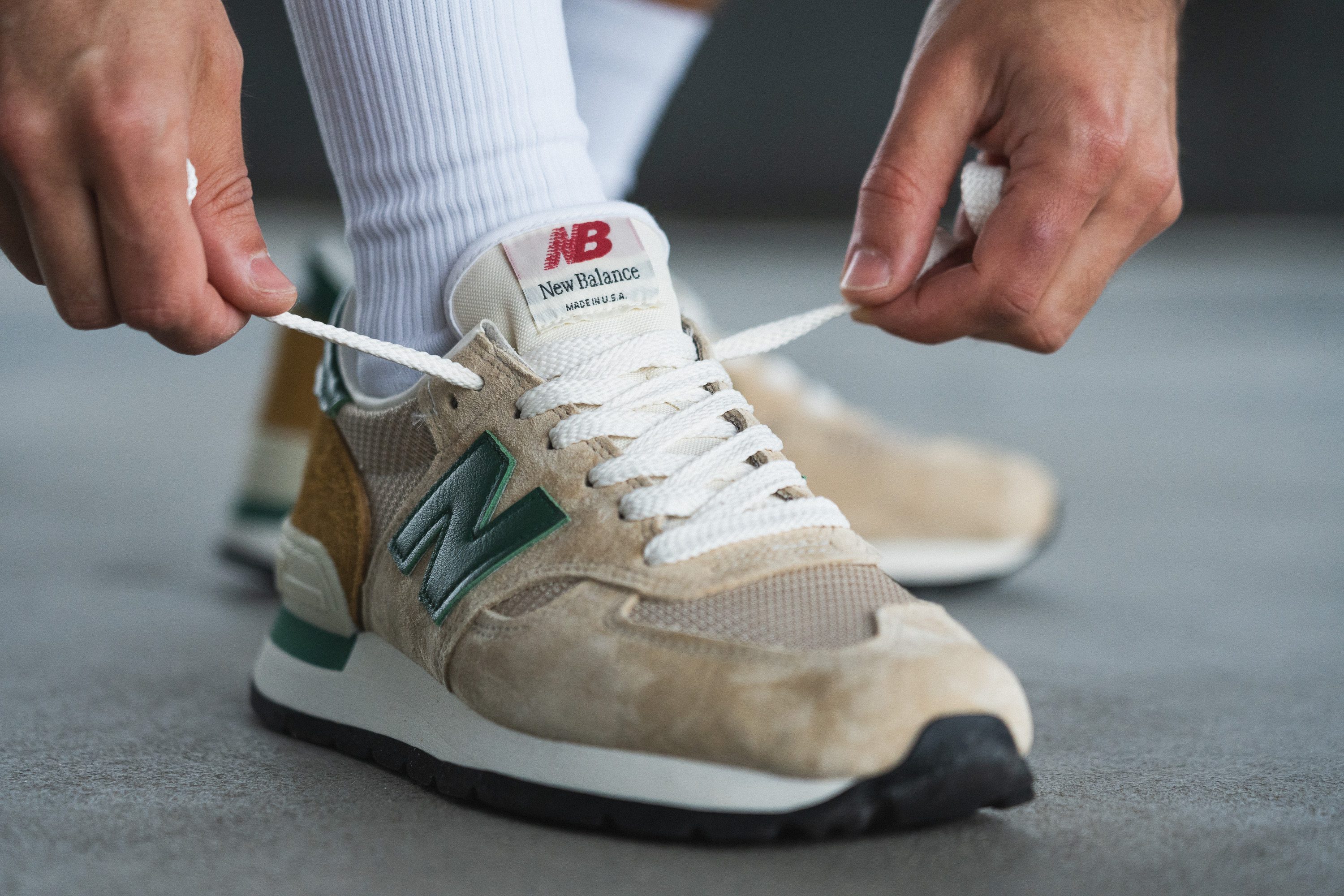
What was it that convinced buyers to shell out and welcome the shoe so warmly? Here are some of the most common assumptions:
- The 990 v1 had truly premium quality materials and craftsmanship.
- It was marketed as a US-made product which was a rare case at the time.
- It features an innovative Motion Control Device which stabilizes the foot.
- The shoe managed to combine great arch support and flexibility which was a novelty back then.
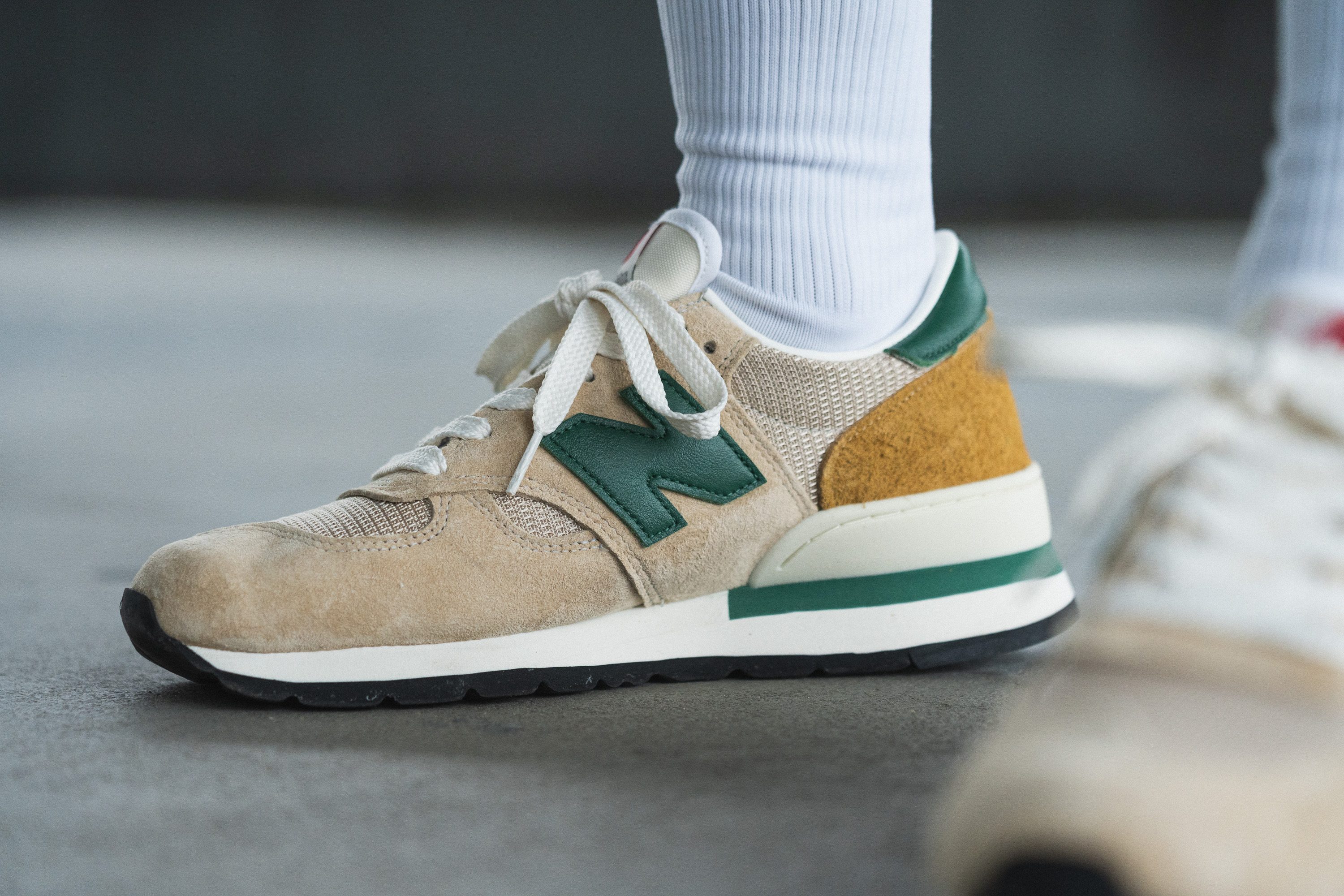
The New Balance 990 pioneered the highly sought-after New Balance 99X Series. The NB 99X Series is a lineup of shoes produced by the brand with design and construction originating from the original 1982 NB990 model.
Overall, the 990v1 was such a success that it wasn’t until 16 years later that New Balance decided to introduce its successor, the v2.
